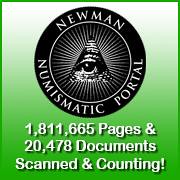
About UsThe Numismatic Bibliomania Society is a non-profit organization devoted to the study and enjoyment of numismatic literature. For more information please see our web site at coinbooks.org SubscriptionsThose wishing to become new E-Sylum subscribers (or wishing to Unsubscribe) can go to the following web page link MembershipThere is a membership application available on the web site Membership Application To join, print the application and return it with your check to the address printed on the application. Print/Digital membership is $40 to addresses in the U.S., and $60 elsewhere. A digital-only membership is available for $25. For those without web access, write to: Terry White, Treasurer AsylumFor Asylum mailing address changes and other membership questions, contact Terry at this email address: terrywhite5475@yahoo.com SubmissionsTo submit items for publication in The E-Sylum, write to the Editor at this address: whomren@gmail.com BUY THE BOOK BEFORE THE COINSale Calendar
|
- WAYNE'S WORDS: THE E-SYLUM APRIL 11, 2018
- KOLBE & FANNING SALE 149 CLOSES APRIL 28, 2018
- NEW BOOKS: CHOPMARKED COINS IN SPANISH AND ITALIAN
- NEW BOOK: THE WAR AGAINST CASH
- EL SITIO NO. 26 PUBLISHED
- NEW AUDIO: CDN LAUNCHES BOTH SIDES OF THE COIN
- NEWMAN PORTAL ADDS GREEN ESTATE SETTLEMENT RECORDS
- NEWMAN PORTAL SEARCH: FORRER
- NUMISMATIST JAN LIS AND THE BEAVER COIN ROOM
- APRIL FOOLS ISSUE, 2018
- NOTES FROM E-SYLUM READERS: APRIL 8, 2018
- THE 1776 JANUS COPPER
- CONTINENTAL DOLLARS REVISITED
- VOCABULARY TERM: SERIES
- MARSHALL CLIFFORD LEFFERTS (1848-1928),
- HARVEY STACK'S NUMISMATIC FAMILY, PART 15
- NEIL SHAFER'S RED BOOK RECOLLECTIONS
- DON EVERHART AT THE FRANKLIN MINT
- QUERY: BANKNOTE PROTECTOR PRINTING
- WASTWEET WINS AMERICAN MEDAL OF THE YEAR AWARD
- 2018 IPMS SYMPOSIUM SPEAKERS ANNOUNCED
- ANA SUMMER SEMINAR NUMISMATIC PUBLISHING COURSE
- 2018 ANA SUMMER SEMINAR COURSE CATALOG
- PNG CALLS FOR 2018 AWARDS NOMINATIONS
- NUMISMATIC NUGGETS: APRIL 8, 2018
- THE TERRIBLE NINTH CENTURY
- THE NUMISMATICS OF GOLF
- SCHRAUBTALER: MEDAL WITH A HIDDEN STORY
- HOW THE CHALLENGE COIN TRADITION STARTED
- NIOBIUM COIN CASE STUDY
- ROYAL CANADIAN MINT ISSUES UFO ENCOUNTER COIN
- CANADIAN INSTITUTE FOR THE BLIND COIN DESIGNER
- BANKNOTE FEATURES CANADIAN HUMAN RIGHTS MUSEUM
- GARRETT COLLECTS SMALL SIZE KENTUCKY NATIONALS
- INDIAN COLLECTOR OF ERROR BANKNOTES PROFILED
- THE GLOBGLOGABGALAB
- MOVIE MONEY: THE COINS OF ZAMUNDA
- IN OTHER NEWS: APRIL 8, 2018
- FEATURED WEB SITE: BANKNOTE NEWS
Click here to access the complete archive
To comment or submit articles, reply to whomren@gmail.com
Content presented in The E-Sylum is not necessarily researched or independently fact-checked, and views expressed do not necessarily represent those of the Numismatic Bibliomania Society.
WAYNE'S WORDS: THE E-SYLUM APRIL 11, 2018
 Have you noticed our Newman Numismatic portal page counter at the top right of each issue? It's up to 1,811,665 pages! Click on it to go to the Portal and explore the latest numismatic content.
Have you noticed our Newman Numismatic portal page counter at the top right of each issue? It's up to 1,811,665 pages! Click on it to go to the Portal and explore the latest numismatic content.
This week we open with a new numismatic literature sale from Kolbe & Fanning, two or three new books, one periodical, a brand-new numismatic podcast, and updates from the Newman Numismatic Portal.
Other topics this week include the 1776 Janus Copper, the Continental Dollar, Sculptor-Engraver Don Everhart, medallist Heidi Wastweet, schraubtalers, the numismatics of golf, and the coins of Zamunda.
To learn more about chopmarked coins, Uruguay's Constitution Centennial coinage, Leonard Forrer’s Biographical Dictionary of Medallists, London dealer Jan Lis, joint monarchs on coins, Mudie Medals, the fabulous Anderson Dupont Collection, the Charioteer of the Delphi, Charlemagne, and the Royal Canadian Mint's UFO coin, read on. Have a great week, everyone!
Wayne Homren
Editor, The E-Sylum
KOLBE & FANNING SALE 149 CLOSES APRIL 28, 2018
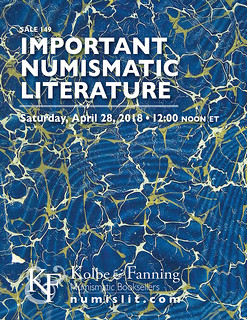 KOLBE & FANNING ANNOUNCE APRIL 28 AUCTION OF NUMISMATIC BOOKS
KOLBE & FANNING ANNOUNCE APRIL 28 AUCTION OF NUMISMATIC BOOKS
Kolbe & Fanning Numismatic Booksellers announce our Sale 149, which will be held on April 28, 2018. The 500-lot sale features further selections from the extensive library of William A. Burd, among others, and covers ancient, foreign and U.S. numismatics.
Some highlights of the sale include:
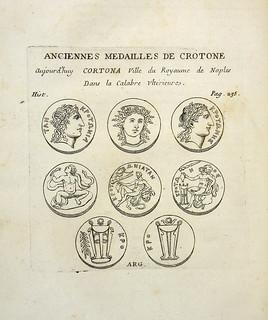
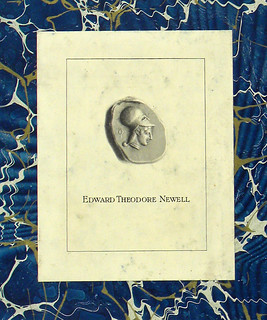
Lot 1
Lot 1: the rarely seen 1717 History of the Académie Royale des Inscriptions et Belles-Lettres, with illustrated content on ancient, medieval and modern coins Lot 21: a plate volume of Babelon’s Traité from the library of Edward T. Newell
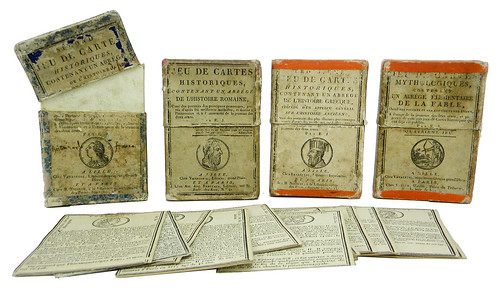
Lot 81
Lot 81: four different decks of c. 1804 French instructional playing cards illustrating ancient, medieval and modern history
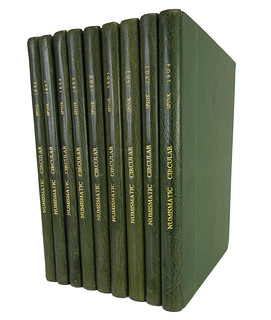

Lots 132 and 143
Lot 132: a complete run of Spink’s Numismatic Circular from 1892 to 2000
Lot 143: the scarce and desirable second edition of Waddington on Pontus & Paphlagonia
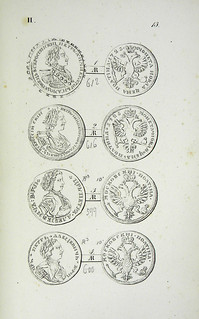
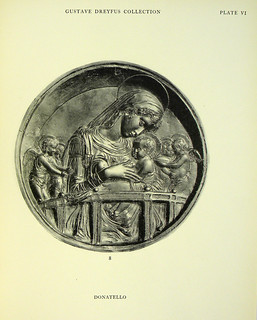
Lots 175 and 183
Lot 175: an original 1836 set of Chaudoir’s Aperçu sur les monnaies russes Lot 183: the Gustave Dreyfus collection of Renaissance reliefs & plaquettes

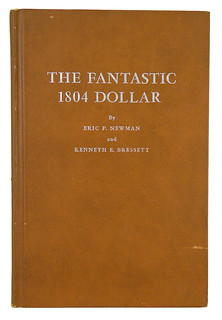
Lots 201 and 450
Lot 201: a remarkable collection of French laws, proclamations and decrees governing assignats
Lot 450: the rare first printing of The Fantastic 1804 Dollar
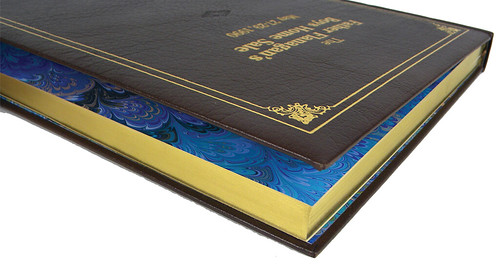
Lot 475
Lot 475: the only copy we have handled of the ultra-deluxe Superior catalogue of the Boys Town collection, bound in full water buffalo skin with a matching clamshell case.
Bids may be placed via post, email, fax or phone, as well as online. Kolbe & Fanning uses Auction Mobility as our third-party online bidding platform. Auction Mobility is an app-based platform allowing users the ability to participate in the sale through phones, tablets and computers. To register for the sale, bidders must go to bid.numislit.com and sign up. Once you have set up an account, you may browse lots, place advance bids, or participate in the live sale online. Those wishing to participate on their devices can download the Kolbe & Fanning app through the Apple or Google Play Store.
The printed catalogue of Sale 149 has been mailed to active customers. A PDF of the printed catalogue has also been posted to our main website at numislit.com for those who prefer that format. Bids placed via post, email, fax or phone must be received by April 27, the day before the sale, in order for them to be processed. Advance absentee bids may also be placed online at bid.numislit.com ; live internet bidding will be available during the sale itself through the same platform.
Kolbe & Fanning Numismatic Booksellers LLC is a licensed and bonded auction firm in the State of Ohio. For more information, please see the Kolbe & Fanning website at numislit.com or email David Fanning at df@numislit.com . To register for the sale, go to bid.numislit.com. We look forward to your participation.

NEW BOOKS: CHOPMARKED COINS IN SPANISH AND ITALIAN
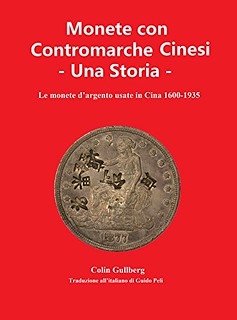
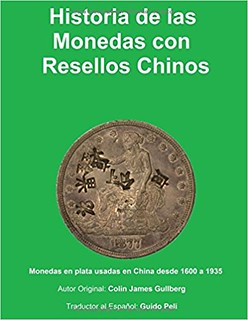
Chopmarked Coins in Italian and Spanish
Colin Gullberg’s book, Chopmarked Coins – A History, is now available in Spanish and Italian editions on Amazon. Translations were done by Dr. Guido Peli.
Chopmarks are a fascinating yet little understood area of Chinese numismatics. The economic history of China in the much of the Qing dynasty and early Republican periods is largely a history of Latin American silver. Chinese farmers paid taxes with Spanish American silver, trade was carried out with Spanish American silver, and when the silver started to dry up Chinese society faced famine, unrest and revolution.
The only evidence of the millions of reales that flowed from Spain’s lands in the Americas to China is the coins and the chopmarks they bear. These marks, applied by private bankers (or ‘shroffs’), are a little studied area of numismatics. Almost nothing has been written on them, little research has been carried out, and few collectors collect them.
Nevertheless, chopmarks are a fascinating area of numismatics. No two coins are the same, the number and variety of chops and the different coins that saw circulation in the Far East seems endless. The history behind the period involves much of the world – but especially Mexico and Peru, the two biggest contributors of silver for much of the Qing dynasty.
Mr. Gullberg wrote what is only the second book ever written on the subject. He is also the editor and president of the Chopmark Collectors Club (CCC). The original print run of the English edition was limited to 500 copies, which are almost completely sold out. Dr. Guido Peli is a long –time collector and is a native of Italy, but has lived in Lima, Peru for many years. It was he who saw the need for editions in other languages and he has done an excellent job of translating the original English text into Italian and Spanish in an attempt to reach a larger collector audience. The Spanish edition in particular should find a large readership as many of the coins that were sent to China during the period originated in Latin America. Both books are available in Kindle (electronic) and paper (print-on- demand) versions. You don’t need to own a Kindle to read the e-version; it can run on any computer.
If the subject of chopmarks interests you then you should join the CCC – the Chopmark Collectors Club. The CCC is a club that is run for collectors, dealers, and other interested individuals. The English-language newsletter, Chopmark News, covers research in the field. A free sample copy can be obtained by emailing chopmarknews@gmail.com .
To order the Italian edition, see: https://www.amazon.es/MONETE-CONTROMARCHE- CINESI-dargento- Italian- ebook/dp/B07B4KBDC9/ref=sr_1_1?ie=UTF8&qid=1522554094&sr=8-1&keywords=Colin+Gullberg
To order the Spanish edition, see: https://www.amazon.es/Historia-Monedas- Resellos-Chinos- monedas/dp/1980352399/ref=sr_1_2?ie=UTF8&qid=1522554094&sr=8-2&keywords=Colin+Gullberg
To read the earlier E-Sylum articles, see:
NEW BOOK: CHOPMARKED COINS - A HISTORY (http://www.coinbooks.org/esylum_v17n27a03.html)
BOOK REVIEW: CHOPMARKED COINS: A HISTORY (http://www.coinbooks.org/esylum_v17n35a07.html)
NEW BOOK: THE WAR AGAINST CASH
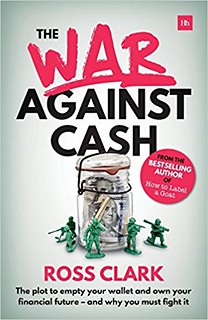 We are constantly being told that we are on the cusp of a cashless society. The financial services industry would certainly like to see it that way. We are being enticed with contactless cards, mobile phone payment
apps, and methods of bank transfer: all, apparently, for our convenience.
We are constantly being told that we are on the cusp of a cashless society. The financial services industry would certainly like to see it that way. We are being enticed with contactless cards, mobile phone payment
apps, and methods of bank transfer: all, apparently, for our convenience.
But as Ross Clark argues in this compelling new book, it is not in our interests to surrender the right to use cash. Commercial interests want us to pay electronically in order to collect valuable data on our spending habits, while governments would love us to move to cashless payments in order to control the economy in ways which suit them, not us.
If we choose to pay electronically, that is one thing, but we will regret it if we do not defend the right to pay with cash.
Ross Clark is a respected journalist who has written extensively for a number of UK newspapers. He is also a best selling political author focussing on matters that are affecting society such as bureaucracy, globalisation and the surveillance society. In ‘The War on Cash’ he is perhaps more concerned about the future than the present, but by making the present danger clear, he exposes a future world not unlike that described in George Orwell’s 1984.
Each of the 14 chapters focuses on a different battleground in the war on cash, including such titles as My Little Car Park Problem, A Matter of Choice, The Cashless Nightmare, Who Would Trust a Bank?, The Negative Interest Rate Trap, Snooping On Our Shopping Habits, Finding Guinea Pigs in the Developing World, and What Would a Cashless Society Really Look Like?
This book presents the case for cash based on events taking place now right across the globe aimed directly or indirectly, at eliminating cash as a means of payment. What he says is happening is a programme of turning economies cashless by stealth. His plea – ‘don’t fall for it. Don’t let anyone tell you this is the modern way to pay and you are being a fuddy-duddy in resisting it. The electronic payments industry is doing its best to control us. We need to understand what is going on and do everything within our power to stop it’.
To read the complete article, see:
Book Review – The War Against Cash (http://www.currency-news.com/issues/december-2017/)
I learned about the book through Ursula Kampmann's article in the April 5, 2018 issue of CoinsWeekly. See below for a link to her article. -Editor
For more information, or to order, see:
THE WAR AGAINST CASH (https://www.harriman-house.com/waragainstcash)
The War Against Cash: The plot to empty your wallet and own your financial future – and why you must fight it
(https://www.amazon.com/War-Against-Cash-wallet-financial/dp/0857196251)
To read the complete CoinsWeekly article, see:
The War against Cash (http://www.coinsweekly.com/en/News/The-War-against-Cash/4?&id=5286)
EL SITIO NO. 26 PUBLISHED
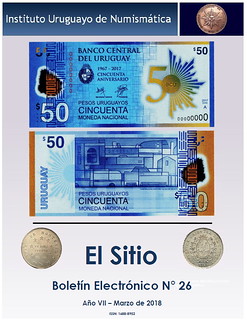 El Sitio No. 26
El Sitio No. 26
Year VII, March 2018, ISSN 1688-8952
Number 26 of “El Sitio”, the electronic magazine of the Instituto Uruguayo de Numismatica, corresponds to the March 2018 edition and has 21 pages containing three feature articles plus the usual information and news sections.

The first article, by Eduardo Cicala, recounts the travails of the secretary of the Uruguayan Bank of the Republic, Raul Montero Bustamante, to comission the 1930 commemorative issue for the Centenary of the Constitution of 1830, highly praised on its artistic merit, for which he secured the work of French artists Lucien Bazor, Pierre Turin, and Alexandre Morlon.

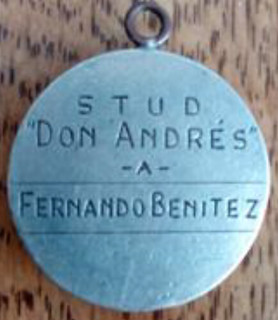
In the second article, “Marela”, Daniel Padula presents a medal portraying the 1950s racehorse Marela, with information on its owner, Julio Folle Larreta, and the Uruguayan horse racing scene.
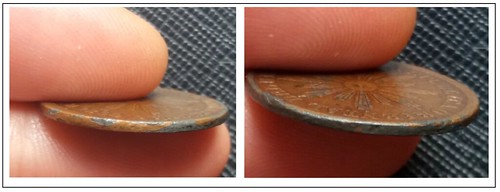
The third article, “By the Skin on His Teeth”, by Giancarlo Cassanello, is a cautionary tale of how a collector recently avoided paying a considerable amount for a fake coin—incredibly, a painted lead piece—bought online, and how an equally surprised and most honest seller quickly reimbursed the balance.
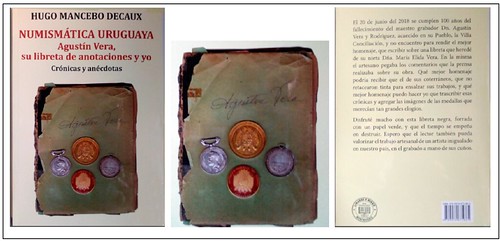
An account of the comradely dinner and end-of-the-year meeting is given in the information section, which also reports on the success of the One Piece, One Story cycle of informal talks. Also, a new book by Hugo Mancebo is reviewed. “Agustin Vera: Su Libreta de Anotaciones y Yo,” or, Agustin Vera, His Notebook and Me, is a book about the life and work of the noted Uruguayan engraver Agustin Vera.
The complete issue can be viewed online (in Spanish) here:
http://iunuy.org/
NEW AUDIO: CDN LAUNCHES BOTH SIDES OF THE COIN
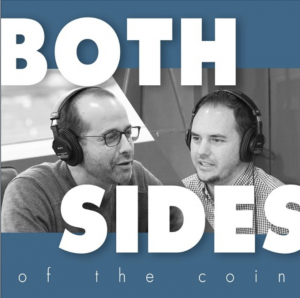 Have you heard? CDN President John Feigenbaum and Editors Patrick Ian Perez and Joshua McMorrow-Hernandez are dishing on the latest market buzz on a new podcast series called Both Sides of the Coin. You can now
listen to every episode of this exciting new series with free downloads from iTunes. These fun, conversational 15- to 20-minute podcast episodes cover various significant news stories and important trends in the coin market.
Some of the things you’ll hear on Both Sides of the Coin range from auction results to new United States Mint releases to virtually everything else that coin dealers and collectors need to know.
Have you heard? CDN President John Feigenbaum and Editors Patrick Ian Perez and Joshua McMorrow-Hernandez are dishing on the latest market buzz on a new podcast series called Both Sides of the Coin. You can now
listen to every episode of this exciting new series with free downloads from iTunes. These fun, conversational 15- to 20-minute podcast episodes cover various significant news stories and important trends in the coin market.
Some of the things you’ll hear on Both Sides of the Coin range from auction results to new United States Mint releases to virtually everything else that coin dealers and collectors need to know.
Both Sides of the Coin premiered in March 2018 and has been racking up hits from fans on YouTube, Facebook, and Twitter. It’s no wonder, as there’s always something new to learn from the guys on Both Sides of the Coin. CDN President John Feigenbaum has decades of experience in the coin industry and brings his keen insights on the latest in pricing, auctions, hoard discoveries, and other fascinating news from the world of coins. Meanwhile, Patrick Ian Perez’s professional background includes many years as both a coin dealer and numismatic writer, and he also loves sharing the scoop on the latest happenings from the paper currency market. CDN newcomer Joshua McMorrow-Hernandez, a longtime coin collector, is a coin journalist and blogger who shares his two cents on an array of numismatic topics.
Reaching an international audience via the internet, Both Sides of the Coin provides not only an informational, educational, and entertaining peek into the latest numismatic stories, but it also serves as an editorial arm for CDN’s flagship publications, such as Greysheet, Bluesheet, Greensheet, and Goldsheet. This assures that those who read our publications in print or online can now gain more informational context on the market activity from the very experts who deliver the essential coin pricing data that countless coin dealers, collectors, and others have trusted since 1963.
Patrick writes:
I have enjoyed doing the episodes so far and it's nice to have an opportunity to be opinionated on our hobby and offer our unique perspective.
Josh adds:
As for me, I’m just getting used to finding my natural “on-air” presence. I’m totally new to this, but I’m sure I’ll break myself in better as time goes along. Otherwise, I find the podcasts a lot of fun on my end.
The podcasts give us at CDN the opportunity to engage in a conversation with the numismatic community and share what's happening throughout many areas of the industry.
To download the podcasts, see: Both Sides Of The Coin (https://itunes.apple.com/us/podcast/both-sides-of-the-coin/id1355413928)
To read the complete article, see:
“Both Sides of the Coin” Podcast Now Available for Free from iTunes (http://blog.greysheet.com/both-sides-of-coin-itunes/)
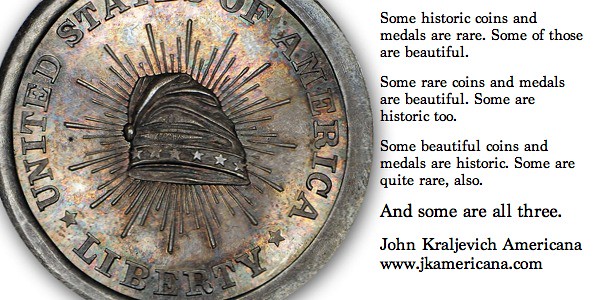
NEWMAN PORTAL ADDS GREEN ESTATE SETTLEMENT RECORDS
Newman Portal Presents Settlement Records from the Col. Green Estate
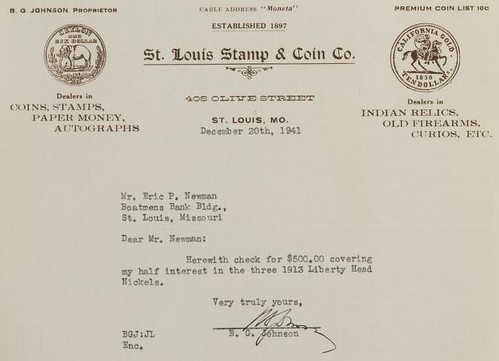
In 1939, Eric P. Newman began negotiations with the Chase National Bank in New York to purchase the numismatic collection held by the Col. E. H. R. Green estate. Newman and St. Louis dealer Burdette G. Johnson made piecemeal purchases over time, which Johnson sold on behalf of the partnership. These records indicate sales made by Johnson, with Johnson sharing half of the proceeds with Newman. The file also details a small number of sales made by Newman on behalf of the Newman/Johnson partnership (primarily colonial paper money). Occasional correspondence between Newman and Johnson is contained throughout the file. The records end with the death of Johnson in February 1947.
The file contains various tidbits on the purchase (and sale) of the 1913 Liberty nickels. On December 20, 1941, Johnson transmits a check to Newman for $500, representing 50% of their cost for three of the pieces. On December 24, Johnson forwards advice on negotiating for the two remaining pieces. A March 24, 1943 note from Johnson to Newman indicates the sale of one of the pieces at $750. These notes were quickly found - a careful search may reveal more!
Link to Col. Green estate records on Newman Portal:
https://nnp.wustl.edu/library/archivedetail/525504
NEWMAN PORTAL SEARCH: FORRER
This week a Newman Portal user searched for “Forrer.” One of the most commonly consulted sources on the Newman Numismatic Portal is Leonard Forrer’s Biographical Dictionary of Medallists, a massive 8-volume set containing capsule summaries of engravers and coiners. These volumes have been widely scattered on the Internet for some time, while in contrast the Newman Portal presentation is complete and straightforward, simply listing the six regular volumes with letters covered by each, plus the two supplements. Forrer was active at Spink in London at the turn of the 20th century and headed its coin department. The Biographical Dictionary surely consumed a great deal of his free time and was published piecemeal from 1904 to 1930.
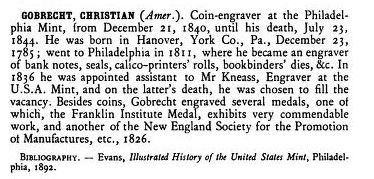
Image: Forrer’s entry on Christian Gobrecht, from volume 2 (1904).
Link to Forrer’s Biographical Dictionary of Medallists on NNP:
https://nnp.wustl.edu/library/books?searchLetter=B
NUMISMATIST JAN LIS AND THE BEAVER COIN ROOM
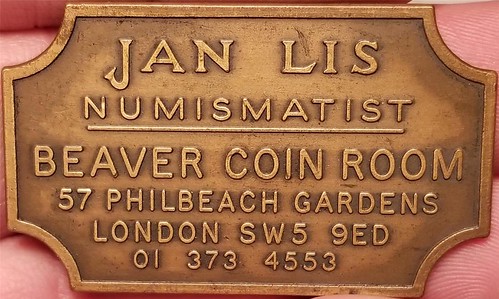
Frank Robinson writes:
I remember him — he's involved in mostly medals. One time — decades ago — I had what I thought must be an interesting Venetian medal, brought it with me to a New York Int’l show, and somebody said Jan Lis would be my man. So I found him, he said he’d give me $100, just like that, and I was very pleased.
That was my sole encounter with him. Funny, I can actually picture what he looked like. Funnier still, only recently I happened to remember that episode for some reason, but I couldn’t think of the guy’s name. Then I saw your item and it clicked!
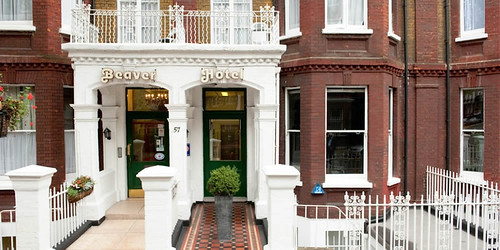
Phil Mernick of London writes:
Jan is a still active and is to be found at all of the London, Holiday Inn coin fairs. The Beaver Coin Room is at The Beaver Hotel which he owns, but I don’t think it is visitable.
From the site of the British Numismatic Trade Association:
Beaver Coin Room
Specialities
European coins from the Middle Ages to the 18thC. Polish coins a specialty. Commemorative and artistic medals from the Renaissance to the 20thC.
To more information, see:
Beaver Coin Room (http://www.bnta.net/index.cfm?do=individualmember&id=8)
Beaver Hotel (http://www.beaverhotel.co.uk/)
George Kolbe writes:
My wife Linda and I stayed at the Beaver Hotel in London on two different occasions, in the 1980s if memory serves. Rooms were available with communal bathrooms or in-room ones; we chose the latter. A full English breakfast was included. The hotel is well-situated and we enjoyed both of our stays there.
The proprietor of the hotel was and is none other than Jan Lis, and the Beaver Coin Room is situated on the premises. Unfortunately, on both occasions, Jan Lis was away from the hotel and we were not able to visit the coin room. Over the years, we often met in New York at NYINC, in London, and other European cities when major numismatic libraries were being dispersed.
Medals are Jan’s numismatic specialty and his library on that topic is exceptional. Jan is among those pleasant friends and acquaintances that have made numismatic bookselling such an enjoyable adventure.
Ira Rezak of Stony Brook, New York writes:
Jan is a friend of mine, a coin dealer who runs the Beaver Hotel in London! His collecting specialty is the coins and medals of Poland.
I've known Jan since the 1970's when he first came regularly to the New York international Coin Show and have visited the Beaver Coin Room, which is located in the Beaver Hotel, many times since and as recently as last year. I believe that Harry Waterson's advertising plaquette dates to the 1980s.
Attached are images of Jan Lis' private medal, cast in bronze, 100 mm in diameter, by Jane McAdam Freud; it commemorates Jan's 47th birthday in 1988. The reverse shows a beaver (referencing the Beaver Coin Room) and a Fox, along with water lilies and a fleur-de-lis. The Latin translates as "not a lily but a fox" because one might have assumed that Lis meant lily, as it does in French, while it actually means fox in Polish, Jan Lis's familial language and his principal numismatic collecting interest.
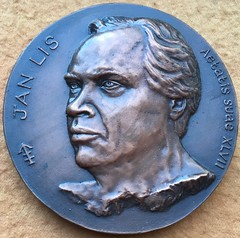
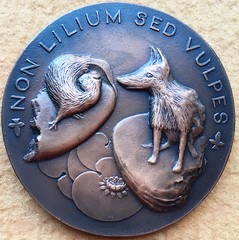
To read the earlier E-Sylum article, see:
NUMISMATIC NUGGETS: APRIL 1, 2018 : c1970 Jan Lis Numismatist Business Card Medal (http://www.coinbooks.org/v21/esylum_v21n13a27.html)

APRIL FOOLS ISSUE, 2018
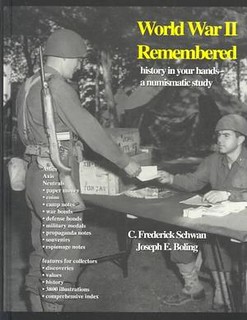
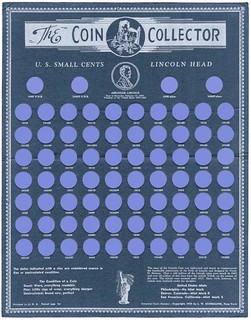
Joel Orosz writes:
Great April Fool's story on World War II Remembered being made into a major motion picture. I knew it had to be a prank because if they ever make a numismatic movie, I'll surely be offered the leading man's role!
Seriously, this story is a fitting addition to your great catalog of past pranks, including the ANS-ANA Merger, which still makes me chuckle to think about it!
To read the earlier E-Sylum articles, see:
RIGHTS TO WORLD WAR II REMEMBERED SOLD (http://www.coinbooks.org/v21/esylum_v21n13a08.html)
BLOCKBUSTER ANNOUNCEMENT: ANA, ANS TO MERGE; DUPLICATE SALE PLANNED (http://www.coinbooks.org/esylum_v10n13a04.html)
APRIL FOOLERY: NO, THE ANS ISN'T MERGING WITH THE ANA. HOWEVER... (http://www.coinbooks.org/esylum_v10n14a02.html)
Dennis Tucker of Whitman Publishing writes:
The Mega Red press release was an elaborate ruse. The 4th edition is actually devoted to trimes, not dimes!
To read the complete article, see:
NEW BOOK: MEGA RED 4TH EDITION (http://www.coinbooks.org/v21/esylum_v21n13a04.html)
Dave Lange writes:
Gene Brandenburg's 1911 half eagle is a Philadelphia coin in at least one respect---the dies were made there.
He can have it fixed by NGC at no charge, but if wants the label to note that it's the scarce repunched mintmark variety FS-501, that will be a $15 fee!
For more information, see:
Indian Head $5 (1908-1929) (https://www.ngccoin.com/variety-plus/united-states/gold-half-eagles/4120/815696/)
Chris Bower writes:
You know I looked for that "S" for at least 5 minutes before realizing what day you published it.
To read the earlier E-Sylum article, see:
NOTES FROM E-SYLUM READERS: APRIL 1, 2018 : A Rare 1911 $5 Gold Piece (http://www.coinbooks.org/v21/esylum_v21n13a17.html)
Dave adds:
Oh, and by the way, my story of the blue coin board was an April Fool's Day joke, provided courtesy of PhotoShop.
To read the earlier E-Sylum article, see:
COIN BOARD NEWS SPRING 2018 ISSUE PUBLISHED (http://www.coinbooks.org/v21/esylum_v21n13a09.html)
Pete Smith writes:
I woke up on Sunday morning with the realization that it was the first of April, Easter and April Fools Day. My next thought was, "I wonder what Wayne is going to put in the issue of The E-Sylum tonight. Following are some observations.
1. I questioned the sale of the rights to World War II Remembered. Then I got to the final paragraph. I can see Joe Boling as General McArthur and Tom Hanks as Boling. However, casting Schwan as Eisenhower and Brad Pitt as Schwan could only be a delusion in the imagination of Schwan.
2. The grading services make occasional errors with their labels. I have handled pieces marked with the wrong denomination or mint mark. Some dealers may find a market for such errors. I have sent pieces back to be relabeled at no charge.
Gene Brandenberg writes about a 1911 $5 gold piece with a labeling error. I am not sure if this is Gene's April Fools joke or Wayne's.
3. Then there is the story of rabbit coins that multiply. I would think that people would be eager to find extra coins obtained at no cost.
4. Finally I found the article Coin Collecting Goes Digital. I followed the link at the bottom to read a whimsical article about sports cards but not about trading digital coins.
To read the original article, see:
From wax packs to mobile apps: Baseball card collecting goes digital to reconnect with kids
(http://www.chicagotribune.com/business/ct-biz-baseball-card-collecting-industry-20180326-story.html)
To read the earlier E-Sylum articles, see:
NOTES FROM E-SYLUM READERS: APRIL 1, 2018 : No Shortage of Rabbit Coins (http://www.coinbooks.org/v21/esylum_v21n13a17.html)
COIN COLLECTING GOES DIGITAL (http://www.coinbooks.org/v21/esylum_v21n13a37.html)
Here's another questionable report published April 1st. If you spotted any others, let us know. Just don't call dealer grades and pricing "fake news". "Wishful thinking" or "creative writing" perhaps, but "fake news" is a little harsh... -Editor
American Breakfast Cereal Coins
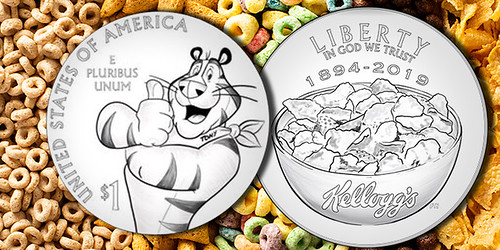
At Friday’s meeting of the Citizens Coinage Advisory Committee (CCAC), design candidate portfolios were reviewed for the American Breakfast Cereal Heritage Act, which calls for a series of $1 commemorative coins that will enter into production in 2019, the 125th Anniversary of the introduction of Corn Flakes.
To read the complete article, see:
First Design for American Breakfast Cereal Heritage Dollar Coin Program Approved by CCAC
(https://coinweek.com/us-mint-news/first-design-for-american-breakfast-cereal-heritage-act-approved-by-ccac/)
To read the last year's April Fool article summary, see: APRIL FOOLS ISSUE, 2017 (http://www.coinbooks.org/v20/esylum_v20n15a02.html)
NOTES FROM E-SYLUM READERS: APRIL 8, 2018
Summa Contra “Obliquely”?
Mike Marotta writes:
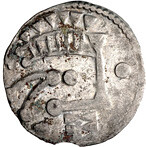 I proposed an article for The Numismatist about “Viewing Coins Obliquely.” Editor Barbara Gregory is interested, but she wants me to include authoritative opposing opinions. Are there any people here who
deny the thesis that some Celtic and other coins were intentionally created to be viewed obliquely in order to present a three-dimensional image?
I proposed an article for The Numismatist about “Viewing Coins Obliquely.” Editor Barbara Gregory is interested, but she wants me to include authoritative opposing opinions. Are there any people here who
deny the thesis that some Celtic and other coins were intentionally created to be viewed obliquely in order to present a three-dimensional image?
To read the earlier E-Sylum articles, see:
VIEWING COINS OBLIQUELY (http://www.coinbooks.org/v21/esylum_v21n09a18.html)
ON ORIENTING AND VIEWING COINS (http://www.coinbooks.org/v21/esylum_v21n10a13.html)
1889 National League Sporting Times Medal Sought
Dave Hirt of Frederick, MD writes:
With the start of the baseball season I came across an interesting baseball item. In the 1943 Higgy sale, lot 1302 is described as:
"Fine gold and silver medal presented by the Sporting Times to the best all around player in the National League in 1889. Four small diamonds at the bases. In original case.:"
I do not have the PRL of this sale. The estimate was $100. Does anyone know more about this medal, or its whereabouts?
Government Opposition to Gold Ownership
David Thomason Alexander of Patterson, New York writes:
Interesting discussion of the American Arts Gold Medallions program in the last issue. One overarching reality was not discussed, however, the total opposition of the U.S. Treasury and Mint to the program and their fundamental opposition to American citizens' interest in gold and gold ownership. For an in-depth examination, please see the "Coin World Comprehensive Catalog and Encyclopedia of U.S. Coins," published in the 1990's. Better yet see my thorough examination of this largely forgotten effort in my updating of Cornelius Vermeule's epic "Numismatic Art in America," Whitman, 2007, pp 212-215.
Treasury wanted the series to fail and did all it could to assure this from omitting statements of weight and fineness, avoiding reeded edges and other coin-like features. Ordering was made deliberately clumsy and packaging was simply abominable on the early releases. The American people had effectively forgotten gold and the Mint had no desire to re-awaken their interest.
Despite design overhauls later in the series, the program was not a success. The whole thing was a sorry mess and yes, it was a failure.
To read the earlier E-Sylum article, see:
ON THE AMERICAN ARTS GOLD (http://www.coinbooks.org/v21/esylum_v21n13a15.html)
Joint Monarchs on Coins
Last week Martin Purdy wrote:
... the wife of a King is usually styled "Queen", the same as Queens who reign in their own right, but only the reigning ones are numbered. But husbands of reigning Queens aren't King unless it's a joint monarchy on theoretically equal terms (Philip & Mary, William & Mary being the only such pairings I can think of off-hand, the Marys being I and II accordingly).
Ken Berger of San Diego writes:
The most famous joint monarchs (although not British) are Ferdinand and Isabella and, coincidentally, Isabella is Elizabeth in Spanish.
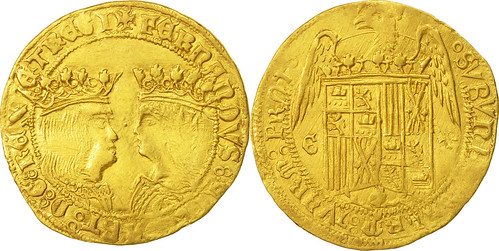
Ferdinand and Isabella, Spain
Coin, Spain, Castille and Leon, Ferdinand V and Isabel Ist, Double Excellentes,Spain, Castille and Leon,Ferdinand V and Isabel (1474-1504), Double Excellentes, Circa 1497, Granada,The busts of the Catholic Monarchs,Eagle with spread wings bearing arms, cross (mintmark) in right field,FERNANDVS ELISABET D G REX ET REGI,SVB VNBRA ALARVM TVARM PROT
Reference:
Double Excellentes Circa 1497 Granada Spain Coin, Castille and Leon, Ferdinand V and Isabel Ist AU(50-53)
(https://www.ma-shops.com/cdma/item.php?id=470962&lang=en)
To read the earlier E-Sylum article, see:
NOTES FROM E-SYLUM READERS: APRIL 1, 2018 : The Many Queen Elizabeths (http://www.coinbooks.org/v21/esylum_v21n13a17.html)
Real Women on U.S. Coins
In an article quoted last week, Lou Golino wrote:
... the only U.S. coins with real women on them are those for the nation’s first ladies (who appeared on the 2006-2016 $10 gold First Spouse coins and the 1999 Dolly Madison silver dollar) and Eunice Kennedy Shriver, who founded the Special Olympics and appears on a 1995 commemorative silver dollar.
Ken Berger writes:
In his article Golino omitted the following U.S. coins which depict real women:
1937 Roanoke Island Half Dollar "depicts" Virginia Dare on the reverse
1893 Queen Isabella Commemorative Quarter
1979-81, 1999 Susan B. Anthony Dollar
2003 Alabama Quarter Dollar depicts Helen Keller on the reverse
2000-Present Sacagawea Dollar
To read the earlier E-Sylum article, see:
GOLINO REVIEWS NEW COIN SERIES HONORING WOMEN (http://www.coinbooks.org/v21/esylum_v21n13a33.html)
2018 TNA Convention medals Available
Regarding their 2018 convention medal, Frank Galindo of the Texas Numismatic Association adds:
We always have great interest in the medals, which is good, not only in Texas but throughout the country. We strike 100 silver medals and 400 bronze medals, The diameter is 39mm, with the silver 10-gauge .999 fine silver and the bronze 12-gauge. One silver and one bronze are sold together as a set. Fifty of the bronze are given to the volunteers who help at our convention, thus leaving 250 single bronze medals to be sold to the public each year. The silver medals are serially numbered on the edge, and some people have the complete set since the TNA medals began in 1969. Each year only a few sets become open, often that’s when a collector dies and the family is not interested in collecting them any longer.
There are a few bronze medals available for sale from some of the previous years. The subjects on most of the medals relate to a person or event in Texas history. This year I honored the Republic of Texas Rangers. Last year I honored the First Texas Navy, 1835-1837 and featured one of the four ships in the First Texas Navy, the Invincible, on the medal. During the ten years that Texas was a Republic, we had two Navies. When we became a state, the remaining ships became part of the U.S. Navy.
To read the earlier E-Sylum article, see:
TEXAS MEDAL FEATURES CAPTAIN JOHN C. HAYS (http://www.coinbooks.org/v21/esylum_v21n13a34.html)
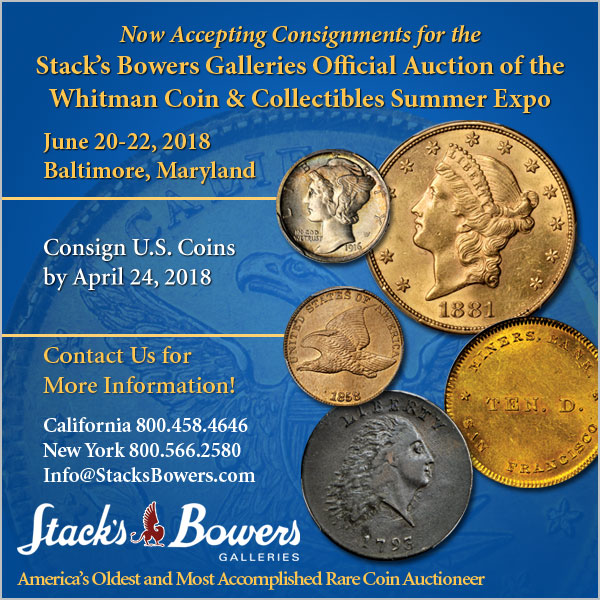
THE 1776 JANUS COPPER
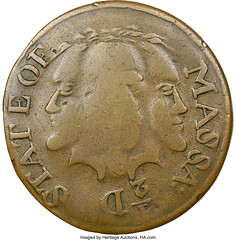
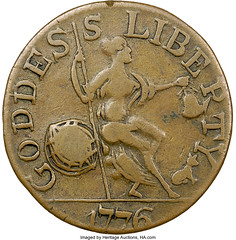
The 1776 Janus copper is among the rarest and most enigmatic coins in American numismatics. A single specimen is known, a celebrated rarity since the earliest days of the hobby.
Traditionally, the Janus copper was believed to be a privately produced pattern for a proposed Massachusetts half-cent copper coinage that was never issued. This view held sway until about 20 years ago, when some numismatists advanced the theory that the coin was a 19th century fabrication, perhaps the work of someone like Thomas Wyatt, the perpetrator of some scandalous forgeries that were discovered in 1856, or C.W. Betts, who began striking his more-innocent reproductions and fantasies around 1860.
Numismatists at Heritage Auctions recently discovered correspondence that indicates the Janus copper was known to early numismatists before Wyatt and Betts began their operations, making it impossible for them to be the authors of this piece.
Matthew Stickney was the first owner of record of this coin and, until now, the first-known numismatic reference to the Janus copper was believed to be the description of this piece in Montroville W. Dickeson’s American Numismatical Manual, published in 1859. The design of the coin features three conjoined heads on the obverse, with the legend “STATE OF” on the left, “MASSA:” on the right, and the denomination “½ D” below. Unfortunately, Dickeson only saw a rubbing of the coin, which is heavily worn on the central obverse, with the middle head nearly effaced. The rubbing seemed to show only two heads, leading Dickeson and others to call this piece the Janus copper, after the two-headed god of beginnings in Roman mythology.
The reverse of the coin shows a seated figure of Liberty (or Britannia). A globe appears in the lower left field and a small animal (either a dog or cat) is at her feet. The legend “GODDESS LIBERTY” hugs the border, with the date 1776 in the exergue.
In The Early Coins of America, published in 1875, Sylvester Sage Crosby noted:
“The only specimen known of this curious pattern is in the collection of Matthew A. Stickney, Esq., and was found with an engraved piece (see plate VII, No. 9,) and some proof impressions from plates for continental paper money engraved by Paul Revere; from this circumstance Mr. Stickney is inclined to the opinion that they were the work of that engraver. However, this may be, the Pine tree cent, and this Halfpenny sufficiently resemble each other in their workmanship, to be considered the work of the same artist. They were probably private enterprises, as no mention of them is found upon any records.”
When Heritage numismatists in 2015 examined Stickney’s papers, which are preserved in the Phillips Library at the Peabody Essex Museum, a May 5, 1854, letter was discovered from New York City numismatist Charles Ira Bushnell to Stickney that specifically asked about the Janus copper. The letter reads, in part:
“I have understood that you had in your possession a coin bearing the following description, Obv: a head with 3 faces. Rev: a figure resembling Britannia. Legends: ‘State of Massa: ½ d’ ‘Goddess of Lib:’ date ‘1776.’ ”
Bushnell wanted to examine the coin for a prospective work on early U.S. coinage he hoped to publish, but apparently never did. This letter predates Dickeson’s work by five years, and pushes numismatic knowledge of the Janus copper to a date before either Wyatt or Betts was operating. It seems likely that Stickney had the coin for some time before Bushnell wrote his letter, and the coin grades VF35 NGC, indicating it was carried as a pocket piece or circulated for a significant period before Stickney acquired it. If Paul Revere struck the coin in 1776 and carried it as a pocket piece for many years before his death in 1818, that could account for the coin’s worn appearance.
On the other hand, opponents of the “Pattern Theory” point out that the abbreviation “MASSA” (for Massachusetts) was not in general use in 1776, and the denomination seems to be incorrect for a half cent, unless D was meant to refer to the English symbol d, for pence, which comes from the Roman denarius. The Bushnell letter does nothing to answer these objections, and it may be that the Janus copper is a 19th century fantasy piece but, if so, it is certainly from an earlier period than previously believed.
David Stone adds:
The Bushnell-Stickney letter from the the Peabody Essex Museum is fascinating, from a bibliophilic perspective, as it outlines a major work by Bushnell that was never actually published. According to this missive, and a follow-up letter he sent later, Bushnell did a remarkable amount of work on this project and was pretty far along with it when he contacted Stickney, but David Fanning says he never heard of any publication by Bushnell on early American coinage. I think he must have turned the whole project over to Crosby 20 years later, as Crosby thanked him in his Introduction for “much of the results of his labors.” The letter is quite lengthy.
To read the complete article, see page 80:
THE INTELLIGENT COLLECTOR SPRING/SUMMER 2018 (http://intelligentcollector.com/mag/pdf-versions/2018-spring-summer-issue.pdf)
CONTINENTAL DOLLARS REVISITED
There is perhaps no more famous verse in the Book of Ecclesiastes than verse 9 of its very first chapter: “What has been will be again, what has been done will be done again; there is nothing new under the sun.”
In January 2018, Erik Goldstein and David McCarthy published an article entitled “The Myth of the Continental Dollar” in The Numismatist which contended that the 1776-dated pieces were not American coins at all, but medals struck in England after the war’s end. The theory, buttressed by solid documentary and contextual evidence, has convinced most skeptics, your author included.
But the papers of Eric P. Newman suggest Goldstein and McCarthy were far from the first to come to this conclusion.
In the summer of 1949, Newman was getting to know Dayton, Ohio dealer James Kelly through the mail. Their exchange of letters began the previous spring but was renewed in July 1949 when Newman admitted to Kelly "your low priced Colonial material has intrigued me." He asked to inspect two rarities: the Confederatio cent of 1785 and a Continental dollar struck in brass.
The Confederatio cent was returned to Kelly on July 20, 1949 after Newman discovered he already owned an example of that variety. “As far as the brass Continental dollar is concerned,” Newman wrote that day, “I have very little enthusiasm for it.” He offered two double eagles as trade bait. Though their value fell well short of the Continental dollar’s asking price, Newman figured he had a shot, reiterating that he “like many others at the present time, have little enthusiasm for the expensive Continental dollars.”
Kelly declined Newman’s offer (though he would have accepted three double eagles of Newman’s choice in trade). On July 25, 1949, Newman offered more perspective on why Continental dollars just weren’t on the top of his wantlist at that time.
“I am sorry that I am returning the Continental dollar in brass. I am still interested in it, but because of recent research of others the evidence points to the fact that these may be satirical pieces made in England after the Revolutionary War and not contemporary pieces. I don't know the facts on this but it may be true. If at a later date you want to get rid of it on the basis I suggested, don't hesitate to let me know.”
Nearly 70 years ago, Newman had heard a theory that, while not precisely the Goldstein-McCarthy concept, was pretty darn close. Where did it come from?
Damon G. Douglas was one of the most well regarded numismatists of his generation. His brief biography here on NNP at once completely undersells his importance as a numismatic researcher and underscores just how forgotten his legacy is today. In the late 1940s, Douglas was considered one of the leading (and perhaps the single most preeminent) researcher of early American coins. He was a leader in the numismatic community, serving on the board of the American Numismatic Association during World War II and as President of the august New York Numismatic Club from 1949 to 1951. In March 1954, the Bronx Coin Club reported that it had “regretfully accepted the resignation of Damon Douglas.” He had burnt out, lost his interest in continuing his research, and set sheaves of excellent but unfinished or unpublished manuscripts aside. Many were donated to the American Numismatic Society after his death in 1974, but after 1954 he is not known to have involved himself in numismatics again.
Douglas’ interests closely paralleled Newman’s own. Surely Newman knew almost everything in the somewhat basic article Douglas penned for the April 1948 issue of The Numismatist entitled “British-American Colonial Coins,” but one paragraph stood out.
“The wave of fast depreciating paper Continental currency seems to have barred other coining attempts during the war,” Douglas wrote. “A possible exception is the so-called ‘Continental dollar.’”
Douglas continued.
“Known chiefly in type metal or pewter, it bears the legends and devices of the paper 1776 fractional Continental currency with the addition of the words 'Continental Currency -- 1776.' Completely ignored by Congress, it was produced, according to Du Simetier's (sic) 1784 notebook, in London probably as a satire on the paper currency that was becoming a synonym for worthlessness.”
The paragraph clearly stuck in Newman’s craw, not only then, but for decades. In 1973, he wrote to the New Jersey Historical Society looking for the notebook kept by pioneering Philadelphia numismatist Pierre Eugene DuSimitiere.
“The late Damon Douglas, who spent much time in your archives doing numismatic research, wrote an article in 1948 mentioning an entry in the diary of Peter Eugene du Simitiere (1706-1784). Do you have that diary in your collection, or have you a suggestion of where it could be located?”
Newman’s archives record no reply. The following day, he jotted a similar letter to the Library Company of Philadelphia requesting information on the diary, recalling Douglas’ 1948 article and calling him “a fine researcher.” Again, no reply is included in the Newman archive. Newman also requested DuSimitiere’s diary at the American Philosophical Society, but apparently never located where it actually was: the Library of Congress, where Goldstein located it in 2017.
This is a story of what-ifs. What if Damon Douglas hadn’t given up on coins in 1954? Might he have published a further expose on the Continental “dollars” decades ago? What if Eric Newman had access to the Internet in the early 1970s, whereby, instead of finding dead ends with unanswered letters, searchable databases of major institutional holdings could have revealed the location of DuSimitiere’s papers easily? What if the Newman Numismatic Portal had existed when Douglas’ numismatic career ended, offering a universally accessible repository for his world-class research, rather than having his papers lay undiscovered for decades and little used in the collections of the ANS?
This saga also points out the inefficiency of numismatic research. Much of what modern researchers “discover” was found but forgotten, written but misplaced, or published but little understood decades ago. While original documents (like the explanatory “explication” on the Continental “dollar” that was preserved in the British Museum but never properly described) are the mother’s milk of good research, underutilized secondary sources can lay a trail of breadcrumbs back to sources that have never been scrutinized by modern numismatists. A surfeit of sources is a wonderful problem to have. And, in many ways, the Newman Numismatic Portal is the solution.
Of course, the EXISTENCE of a repository is only a first step; people must not only use it but learn to use it well. And the repository itself has a responsibility - to make it easy for people to find what they seek and leave bread crumbs behind to guide future researchers. (Pop culture reference #3:) The Ark of the Covenant is somewhere in the warehouse we saw at the end of Indiana Jones, but where? HAVING a vital document somewhere among its millions of pages is huge, but it's only of use if people can find it when they need it.
Meanwhile, I urge readers interested in the Continental Dollar to have a look at the January 2018 Numismatist article. I'm hoping to get permission to excerpt it along with some key images. -Editor
To read the complete article, see:
Continental Dollars Revisited (https://nnp.wustl.edu/blog-post/516273)
VOCABULARY TERM: SERIES
Collectors of coins generally start with a series of coins – Lincoln cents are the most common series for American collectors – so the concept of Series is familiar to most collectors. But issuing similar numismatic items in series is nearly 200 years old with the creation of a Series of Mudie Medals (That’s a man’s name, not dirty medals!)
Series. An issue of a number of numismatic or medallic items with a common theme or design and a continuity in their issue. When a number of related items are issued at one time, this is considered a SET. It is only when similar items are issued over a period time that constitutes a series. The concept of series developed with the early precepts of medal marketing. A collector of medals, an early publisher -- James Mudie in 1820 -- reasoned, would medal buyers want more than one medal to form a collection, or suite of medals. Why not supply this finite number on a subscription basis to form a ready made collection? Thus medals were issued in series periodically with a single continuity of theme.
For the next two centuries the most popular themes for series have been the heads of state, numismatic and professional organizations – or art medals for collectors. English kings have been recorded by medal series, the French created a series for their famous Frenchmen, and, while not intended as a series, Papal medals have been issued for a thousand years.
Art Medal series, in contrast, are issued for the sheer pleasure of owning an attractive medallic work of art. The first began in 1889 when the French medallist Roger Marx created the Société des Amis de la Médalile Française. A similar organization was founded in Brussels in 1901 for Dutch and Belgium medallists, Société Hollandaise-Belge des Amis de la Médaille d’Art.
Coin series. A series of coins is usually a run of similar items of the same denomination and type. These are generally the creation of one or two artists with the design repeated. These are identified by year of issue and the date they bear, and often a mintmark indicating the mint of issue. Thus a series of coins differ only slightly from each other despite the fact they are issued over a period of years.
Medal series. Medals in series, however, are generally uniform in size, shape and composition – but not necessarily by the same artist. Series medals are usually sold by subscription and issued over a period of time, where maybe one or two medals are released at a time. Also similar medals by the same publisher issued over time may be considered a series by collectors and numismatists where, perhaps, they were not so intended originally; the series of presidential medals issued by the United States Mint is such a series.
History of medal series. To James Mudie (flourished 1815-20), a London entrepreneur, must be given credit as the first medal publisher to issue medals – by series – on a broad basis. For his Mudie’s National Medal Series of forty medals, he hired Edward Thomason (1769-1849) to strike the medals (beginning in 1820) in his Birmingham plant from dies engraved for the most part by French engravers.
Thomason went on (without Mudie) to create a 48-medal series on the Elgin Marbles, a 16-medal series, the Medallic Illustrations of Science and Philosophy, the 36-medal series of the Kings and Queens of England. His most notable medallic undertaking, however, was his famed 60-medal series: the Thomason Medallic Illustrations of the Bible.
The Paris Mint issued their first series of medals in their famous Frenchmen of the 18th century. Here, like the later U.S. Mint, these may not have originally been intended to be a series, but similarity of issue bring to mind this classification by numismatists and that is how they are collected.
U.S. Mint series. A most interesting early series was the American Art-Union Medals as prize medals to promote a lottery similar to an undertaking in England. Each medal bore a portrait of a contemporary artist: Washington Allison (1847), Gilbert Stuart (1848) and John Trumbull (1849). The medals were struck at the Philadelphia Mint and distributed to member-subscribers, but lasted for only three years.
Following the Civil War the United States Mint gathered together several 3-inch medals bearing portraits of the American presidents already issued. It added the few missing presidents and continued this until the present time for, perhaps, the longest running series (but not the largest number of medals in a series) in America.
The U.S. Mint began a series with three furtive issues in 45mm size: the Union Pacific Railroad Medal, 1869 (CM-39), Emancipation Proclamation Medal, 1871 (CM-16) and the Grant Peace Medal, 1872 (PR-14). The first and third bore Grant’s portrait, the second with Lincoln’s. Each medal bore the inscription “Medal Series of The U.S. Mint,” but nothing more was issued.
While Congress bestowed medals to heroes of land and naval battles from the War of 1812 onward, these were grouped together into somewhat of an ersatz series when the first List medals were offered for sale to the public after the Civil War. Today the U.S. Mint issues medals in their series of Secretaries of the Treasury, Mint Directors, and Mint Buildings.
Private U.S. series. The Numismatic and Antiquarian Society of Philadelphia began honoring their president in 1884 with a medal of Charles Edward Anthon. They sought out Lea Ahlborn at the Swedish Royal Mint to prepare the dies and strike the medals. She also engraved the second medal in the series in 1890, two more medals were struck before the series closed, the final medal was of Joseph J. Mickley.
The concept of a presidential medal for the head of another numismatic organization appealed to the members of the New York Numismatic Club. They commenced their series in 1911 with the portrait of Frank C. Higgins. Fortunately they had not one, but two medallists within their own membership. So they had Jonathan A. Swanson prepare the portrait obverse, and Victor D. Brenner the symbolic reverse. By the end of the century they had all 40 presidents honored – the longest running such series still in existence. Brenner’s reverse has appeared on all.
Other numismatic organizations adopted similar medal programs to honor their leaders. The Rochester Numismatic Association began a series in 1913; their president served for only one year so they had 87 medals in their presidential medal series before the end of the century, for the greatest number of such medals. The Token and Medal Society, founded in 1960, has such a presidential medal series, as does the California State Numismatic Association, and others. In the professional field, the American Institute of Architects have a president medal series.
Private medal series. Modern private collector medal series in the United States began with the Circle of Friends of the Medallion in 1907, where it lasted for 12 issues within six years. It was modeled after medallic societies in France and Belgium mentioned above. In 1930 the Society of Medallists was born on the same basis of two medals a year by prominent American sculptors. It continued an unbroken 60-year record of two highly artistic medals for 129 issues, until 1995. Every noteworthy American medallist of the twentieth century -- with the obvious exceptions of Saint- Gaudens and Victor Brenner who both died before the inception of The Society) -- are represented in this series.
A small coterie of companies arose in the 1960s for the purpose of issuing medals in series. The most noted, perhaps, was Presidential Art Medals; this firm published series on U.S. presidents, states, signers of the Declaration of Independence, medicine, aviation, great religions of the world, and major events of World War II. But medals in series experienced a boom in the 1960s with the rise of PRIVATE MINTS. Franklin Mint, the first and most productive, issued over 60 different series from 1960 to 1980 when the demand dissipated. The market, it was learned, just could not absorb any more such series at the time.
Aborted Series. A small number of series are aborted before completion of their announced intentions. Often this is the result of the death of an artist who intended to do the entire series. Examples of this include Ralph J. Menconi (1915-1972) who died before the full compliment of 25 medals in his Great Religions of the World Series were struck. Sixteen medals were issued before his November 1972 death, he had prepared the models in advance for two additional medals and these were issued in due course. Seven of the 25, however, were never issued.
In other cases the result of the cessation was lack of interest or poor sales. The series of Philip Kraczkowski (1916-1996) were particularly noted for this. Only three of his Executive Branch Series were issued, one of
his Musical Hall of Fame Series, and three Living Free Series.
CLASS 11.4
Looking for the meaning of a numismatic word, or the description of a term? Try the Newman Numismatic Portal's Numismatic Dictionary at: https://nnp.wustl.edu/library/dictionary
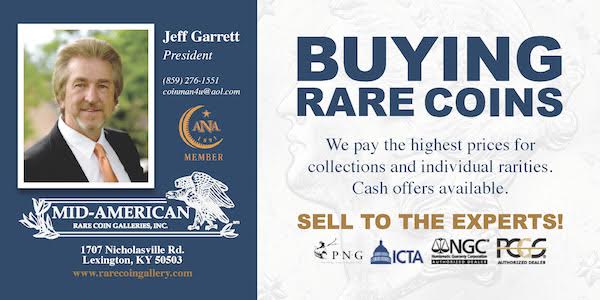
MARSHALL CLIFFORD LEFFERTS (1848-1928),
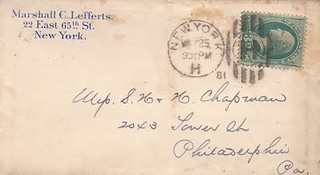 Marshall Clifford Lefferts (1848-1928), was born on November 28, 1848, at New York, son of General Marshall Lefferts (1821-1876) and Mary Allen Lefferts.
Marshall Clifford Lefferts (1848-1928), was born on November 28, 1848, at New York, son of General Marshall Lefferts (1821-1876) and Mary Allen Lefferts.
His father Gen. Marshall Lefferts was president of the Gold and Stock Telegraph Company, a subsidiary of Western Union, New York, and the Celluloid Manufacturing Company, Newark, New Jersey. In 1871, Lefferts became a partner with John Wesley Hyatt in the Celluloid Manufacturing Company. The Celluloid factory at Newark manufactured combs, brushes, knife handles, and cuffs and collars for men's shirts. Lefferts became a major financier of Thomas Edison supplying him with capital to research and develop his inventions.
Marshall C. Lefferts took over his father's interest in the Celluloid Manufacturing Company, Newark, New Jersey, after his father's death in 1876.
On April 9, 1878, he married Carrie Ella Baker (1856-). They had two sons Franklin and Marshall C. Lefferts.
Besides coins Lefferts was a collector of rare books and manuscripts. His library was sold at auction by Bangs & Company, April 21, 1902.
He died April 30, 1928. He is buried at Green-Wood Cemetery, Brooklyn, New York.
To read the complete article, see:
LEFFERTS, MARSHALL CLIFFORD (https://sites.google.com/a/numismaticmall.com/www/numismaticmall-com/lefferts-marshall)
The entire inventory of the Lupia Numismatic Library is for sale. Individual items will be available before the remaining archives are broken up into parcels sold at philatelic auctions in the U. S. and Hong Kong. Check NumismaticMall.com frequently as dozens of new items with estimates will be posted daily until everything is sold.
All inquiries will be given prompt and courteous attention. Write to: john@numismaticmall.com .
HARVEY STACK'S NUMISMATIC FAMILY, PART 15
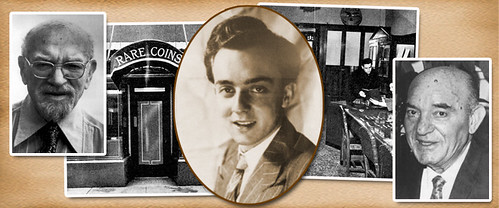
• As noted before, in 1953 my uncle, J.B. Stack, traveled to Lawrence, Massachusetts to appraise an estate collection there. He made an offer and eventually received a call that his appraisal was accepted, and that our offer for the collection would be also accepted. J.B. was delighted. Since he did not drive and he and Morton were needed at the shop, I went to pick up the collection, which was to be the Davis Graves Collection. It had been stored in an abandoned weaving factory, watched over by a caretaker (I told of my packing and taking the collection back to New York in an earlier story). It consumed a portion of the funds we had reserved for purchases from the Farouk sale. However, it was a great collection, mainly large cents, but with numerous early colonial coins, not seen on the market for many decades. Because of the detailed cataloging it required, it could not be sold before the early part of 1954.
In the late fall of 1953, my father and uncle met with an attorney about an estate in Connecticut. The collection had been assembled over 50 years, contained many premium coins, and was almost complete in a number of U.S. series. Because of the size and extent of the collection, my father, Morton, and Uncle J.B. traveled to the bank that stored the collection and they both examined it completely. They started at opposite ends of the conference table where the coins were laid out, examined the coins and wrote down a figure as to what should be paid for each group. A few hours later, they compared their notes and found that each had come up with virtually the same figure. The value was in the many hundreds of thousands of dollars and the two figures were separated only by $2,300. They checked each other's notes and found that on their way around the table, one did not include a small set that the other did. It was remarkable! They made an offer that was accepted by the banker and trust officer and this brought to New York the fabulous Anderson Dupont Collection of gold, silver and copper coins. Many early Proof coins were included in the collection and it also had a "hidden collection" that was left to the heirs of the company for eventual sale and that few ever saw.
The purchase of the Anderson Dupont Collection consumed much of the remaining capital that had been set aside for the Farouk sale. However, as we always said in the family, "A bird in the hand was worth two in the bush." This was the way the firm built inventory, so when a client came in looking for something, it was in stock and available for sale. No matter whether it was a common Indian Head cent or a great rarity, if you didn't have it, you couldn't sell it.
As my uncle and father were both involved with the chores they always had for the business: traveling, working in the shop or cataloging a collection, I was tasked with the daily work of keeping the office and store going. In addition, I traveled a bit, when a convention might be too long for my uncle, appraising and/or buying collections we were offered, or selling special items to clients. I was one of the first numismatists to be a member of the American Society of Appraisers and learned by working side by side with my uncle how to be a public auctioneer.
The year 1953 was an important one for me and for Stack's. It also set the stage for important events in the years to come.
To read the complete article, see:
Harvey Stack Remembers: Growing up in a Numismatic Family, Part 15 (http://www.stacksbowers.com/News/Pages/Blogs.aspx?ArticleID=2926)
To read the earlier E-Sylum article, see:
HARVEY STACK'S NUMISMATIC FAMILY, PART 14 (http://www.coinbooks.org/v21/esylum_v21n12a17.html)
Harvey writes:
This June, I will be 90 years old, and hope that the noggin keeps functioning, so I am glad that I have, and can, be able to recite things that happened way back then. My love of the hobby, and the people I encountered keeps me "young".
I hope my experiences will be model for the current group of dealers, and that they can and will maintain the love and affection for the hobby, and give the best they can to make the hobby grow again, and realize that being a dealer is both an avocation as well as a vocation, and if you do it right by all, everyone will prosper while teaching others the glory and satisfaction of being a numismatist.
The first automatically sliced commercial loaves were produced on July 6, 1928, in Chillicothe, Missouri, using a machine invented by Otto Rohwedder...
For more information on the birth of sliced bread, see:
Who Invented Sliced Bread? (https://www.history.com/news/hungry-history/who-invented-sliced-bread)
Harvey adds:
For the record, I was born on June 3, 1928 and am still crusty !!!
NEIL SHAFER'S RED BOOK RECOLLECTIONS
My participation in the preparation of this book was somewhat limited, as my particular fields of activity centered more on world numismatics. Yet each year around April, when the next edition was in earnest preparation, I was called upon to work alongside Dick Yeo and Ken Bressett in entering values and doing anything else there was to be done editorially in order to get the book ready for publication.
In order for us to be able to work uninterruptedly and in a peaceful atmosphere, we always went to stay for a few days at Lake Lawn Lodge in Delavan, Wisconsin. As needed, we had guest assistants to provide some degree of guidance with respect to what the coin market had done the past year, and to help with a value structure that would accurately mirror and in some ways predict market activity. Individuals including Ben Dreiske and Art Kagin were such participants, each acting individually, as only one such assistant would work with us during any given session. Remember that in those years the activities of the market were not nearly so frenetic, and the Red Book was the absolute bellwether of all market trends. Its July release date was always very eagerly anticipated by the hobby. In fact, there was so much attention given to what the new Red Book would say that security measures had to be imposed in order to make sure no new information or books leaked out before July!
As an aside, Lake Lawn Lodge had a decoration on each outer door of every room consisting of a little Native American with several feathers, the exact number of which varied slightly from door to door. As we walked the hall to the dining room or to our workroom we would often take notice of these feathers, likening them in a joking way to the tail feather varieties on Morgan dollars!
To read the complete article, see:
Red Book recollections: Neil Shafer (http://news.coinupdate.com/red-book-recollections-neil-shafer/)
DON EVERHART AT THE FRANKLIN MINT
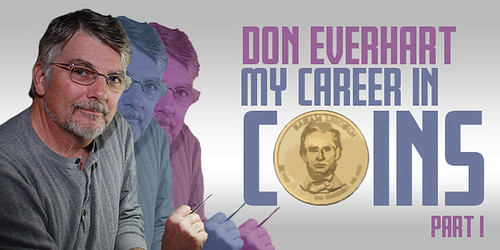
During breaks and at lunchtime I would wander over to the sculpting department and look at the bas-reliefs that were being produced by the artists. The sculptors at The Franklin Mint were held in high regard. In the 1970s the Mint was rolling, its stock splitting every six months or so. I decided that while I had my foot in the door I should try out, as the mint was in need of more sculptors at the time.
At one point, there were 37 sculptors employed full time at The Franklin Mint!
My first tryout piece was “The Charioteer of the Delphi”, a classic Greek figure. It took me three weeks to finish. After that, I was given yet another Greek masterpiece (a bust of Poseidon) and another three weeks. But both were accepted and I embarked on my third tryout piece, which was a scene with Gugliermo Marconi working on his radio telegraph system.
While working on this project I was hired as a Franklin Mint sculptor!
To read the complete article, see:
Don Everhart: My Career in Coins, Part 1 – The Franklin Mint
(https://coinweek.com/modern-coins/don-everhart-my-career-in-coins-part-1-the-franklin-mint/)

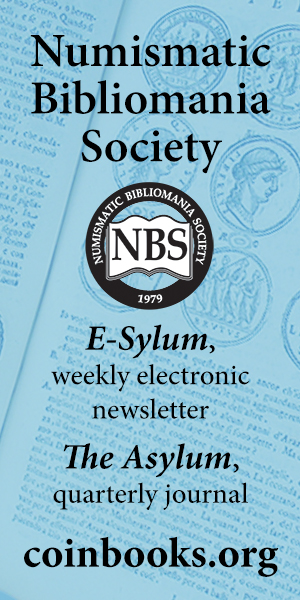
QUERY: BANKNOTE PROTECTOR PRINTING
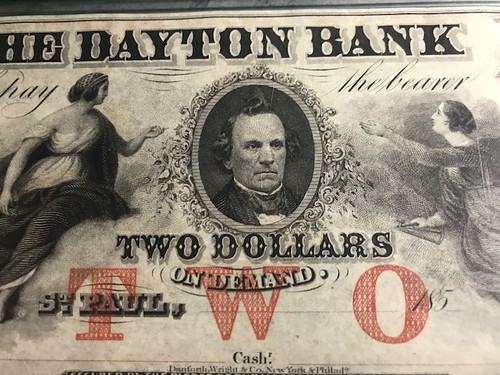
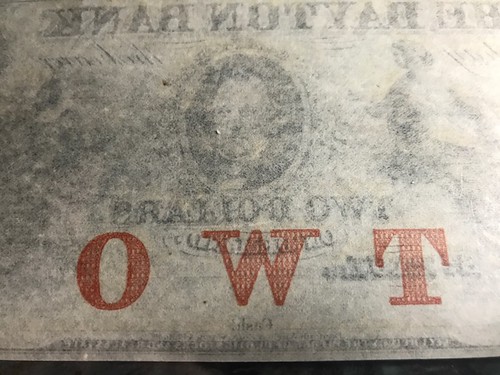
Wendell Wolka of Sun City Center, FL writes:
Another head scratcher....many obsolete bank notes employ protectors as a counterfeit and alteration deterrent. Typically this is printed in color (red, green, blue, etc.) and appears as the denomination spelled out in large letters (ONE, FIVE, etc) across the face of the note. Often the protector image also appears on the the back also perfectly printed (not "soaked through") but as a mirror image as if it HAD somehow transferred through the paper. Two questions...any idea HOW this was printed and number two WHY this was done?
The explanation I have seen of the printing does not explain the process very well. Dave Bowers on page 334 of his 2006 Obsolete Paper Money volume points to the explanation in the 1864 Heath's Infallible Counterfeit Detector, which provides an example of the process as Plate 8. Heath's explanation is as follows (he's referring to the color printing of, say, FIVE or some other denomination on both sides of a bank note):
'The way in which the denomination is printed on both sides of a genuine note is this: In the first place, the die is covered with ink, and an impression is taken from that on a piece of thick paper; the note is then laid on that paper face up and the die stamped on the face; so that the back of the note takes the impression from the thick paper, and both sides being printed from the same die, one side will correspond with the other.'
As someone who prints intaglio, this explanation is a little hard to envision in practice. And it does not seem to explain the perfect registration, face to back, but if the piece of thick paper is exactly the size of the tint plate, maybe that's part of the answer. Perhaps others know of better explanations.
In any case I believe the purpose of the two sided printing is the perfect registration "see-through" effect, which would be difficult to duplicate. Interestingly, this "see-through" concept is very much used on current international bank notes, nicknamed "c-thru" by the modern era bank note designers.
WASTWEET WINS AMERICAN MEDAL OF THE YEAR AWARD

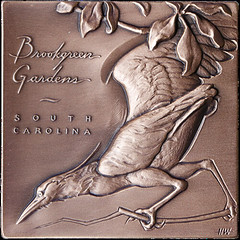
This year, there were over 40 entries for the American Medal of the Year (AMY) awarded by the American Medallic Sculpture Association. Committee Chairman, Mel Wacks, indicates that “The jurors remarked about the high quality of the entries, and took three rounds of voting to choose the winner—a 3 x 3 inch square art medal featuring the Black Crowned Night Heron by Heidi Wastweet, commissioned by Brookgreen Gardens.”
Heidi writes “I chose the Black Crowned Night Heron as my subject based on the large population of them in Brookgreen's Cypress Aviary. About 90% of the birds in the aviary are Black Crowned Night Herons who often trustingly let visitors walk up very close to them. I love spending time watching and photographing these noisy, entertaining birds but they are often overlooked by park visitors so I wanted to highlight them in a beautiful way. The two sides of the medal show two sides of the bird's character - the serious, gruff side, and a playful, goofy side. The composition of the design is intended to not only be pleasing individually on each side but also displayed side by side joined to make a single fluid design so the birds face each other in a yin-yang fashion.”
Just over 1000 medals were struck to be given exclusively to Brookgreen members subscribing at the “Presidents Council” level ($275) and higher. Ordering information can be obtained at www.brookgreen.org/membership or by calling 843-235-6000.

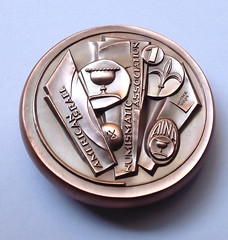
The runner-up was the Shekel Prize Medal by Victor Huster, commissioned by the American Israel Numismatic Association. This extra-high relief medal will be awarded annually to the author of the best published work on the subject of Judaean, Israel, Holy Land or Judaic Numismatics. The medal design features an ancient Judaean Shekel stone weight, an ancient Judaean Shekel from the First Revolt, and a New Shekel coin of Israel (also designed by Huster). A special edition of 10 Artist Proofs were made, and are available for $250 each from AINA by calling 818-225-1348.
All of the AMY entries will be illustrated in the AMSA newsletter. Medal collectors and medallists are invited to join the American Medallic Sculpture Association by sending $40 (US & Canada) or $50 (Foreign) to AMSA, P.O. Box 1201, Edmonds, WA 98020.
For more information on Heidi Wastweet and her work, see:
http://www.wastweetstudio.com/
for more information on the American Medallic Sculpture Association, see:
https://amsamedals.org/
for more information on the American Israel Numismatic Association, see:
http://www.theshekel.org/
2018 IPMS SYMPOSIUM SPEAKERS ANNOUNCED
Speakers Series Lineup
Bill Brandimore
Collecting small size Federal Reserve notes with an emphasis on $5s
Fathom the depths of series, varieties and rarities in the longest running class of small size U. S. currency. Don’t be surprised if you get a heavy dose of examples from Minneapolis, the toughest district to collect,
because its emissions generally were/are the smallest.
Joseph Boling
How fakers messed up their products—laziness or ignorance
Counterfeiters have demonstrated many times that they don’t understand the subtleties of the notes they are copying—or don’t care. You will see many examples of naked-eye diagnostics for identifying bad notes even from poor
images. No magnification required!
Joseph Boling will profile a life consumed by a passion for military currency and financial instruments.
Robert Calderman
Cherry Picking 101: How to score amazing notes without breaking the bank!
Rarity lurks in the shadows so those armed with knowledge own the field. You will learn that you don’t have to be rich to amass a credible and valuable collection. The focus will not be limited to small size U. S. type note
varieties, but instead will range to large size as well as Confederate issues.
Steve Carr
Inside Kansas Nationals—One amazing tale on top of another
The Army National Bank; the Kansas banker killed by the Dalton gang; Two Kansas banks that issued exactly one sheet of a given variety—and these are just the warm ups.
Carlson Chambliss
Philippine emergency paper money, 1941-1945
The outbreak of war in December, 1941 resulted in an enormous need for currency of all forms in the Philippines. The BEP-printed paper money and the silver coinage soon went into hiding. Most of the emergency money was
officially authorized by President Manuel Quezon, but there were many local issues. Several regions did not issue it at all. Central and southern Luzon were so firmly occupied by the Japanese that no emergency money was
issued there. Cebu was the second largest city in the islands, and during late-1941 and early-1942 it produced quality notes, but these were soon suppressed. Notes made in Panay (Iloilo), Negros, and Bohol, all in the
central Visayas, were longer lived. Notes made in Luzon appeared only in the northern provinces. Methods of printing included mimeographs, typewritten notes, and engravings from lead plates. The Culion Leper Colony in remote
Palawan Province had its own currency for a while. The big southern island of Mindanao was able to print and circulate large quantities of currency by frequently sifting its venues for production. Overissue of notes did
become a problem for some regions and many emergency notes went unredeemed after the war.
Ray and Steve Feller
Overprints on WWII Currency
Examples from across the globe of overprints used to monetize wartime currency and/or to acknowledge an emergency situation coupled with warnings about contemporary counterfeits of them.
Jerry Fochtman
Dr. Daniel W. Valentine—postage and fractional currency & half dime pioneer
Valentine (1863-1932) was a numismatic luminary whom you should get to know because he laid the foundation for our knowledge of postage and fractional currency in 1924. His life will be revealed as his numismatic story
unfolds including his efforts to protect his family. This talk is accompanied by an exhibit of Valentine’s personal items.
Pierre Fricke
Counterfeit Confederate money made in the Union
The fascinating history of counterfeit Confederate notes that were made in the Union during the Civil War, either as souvenirs or counterfeits designed to disrupt the Southern economy, will be revealed. Notable are those of
Samuel Upham and Winthrop Hilton, but there were smaller operations in Kentucky, St. Louis and other places.
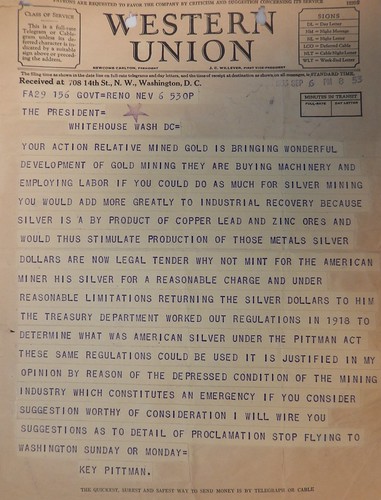
Here is Pittman trying to help out Nevada silver interests and his efforts succeeded with ensuing Roosevelt policies toward monetizing vast stocks of silver.
Peter Huntoon
New Deal Money, the creation of money during the Great Depression
The Roosevelt Treasury caused the greatest tectonic shift in Federal Currency ever to occur in order to rescue the collapsed American economic system during the Great Depression. Emergency currency, demonetizing gold,
monetizing unlimited silver & more—this is the story of all of it.
Roger Urce
Japanese Colonial Issues for Taiwan
Japan exercised influence over Taiwan during the latter part of the 19th century through World War II. All the colonial currency issues will be illustrated and placed into historic context with emphasis on the World War II
emissions.
Jamie Yakes
R & S experimental $1 1935A silver certificates
This will be the first release ever of the complete story of the R & S experimentals—the most collected of all the U. S. currency paper experiments—gleaned from the Federal records left by those who implemented the
experiment. Learn for the first time the composition of the experimental papers and what was learned.
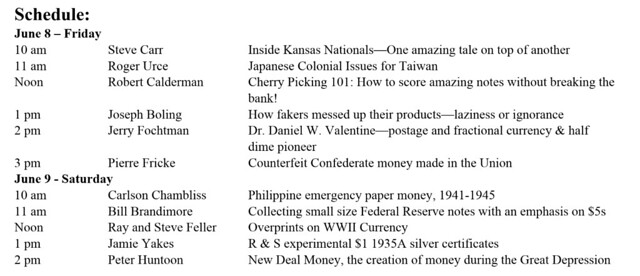
For more information on the 2018 International Paper Money Showa, see:
http://www.ipmskansascity.com/
ANA SUMMER SEMINAR NUMISMATIC PUBLISHING COURSE
Numismatic Publishing Course is Nearly Sold Out
Writers, Editors, Researchers Encouraged to Sign Up Now
An American Numismatic Association course on writing, research, and getting published in the field of numismatics is almost sold out, according to ANA Seminar Manager Amber Bradish.
“Numismatic Publishing: A Practical Course on Writing About Coins” will be taught Sunday through Wednesday, June 17 to June 20, 2018, as part of the annual ANA Summer Seminar. The course instructors are Steve Roach, former editor-in- chief (and current editor-at- large) of Coin World, and Dennis Tucker, publisher at Whitman Publishing.
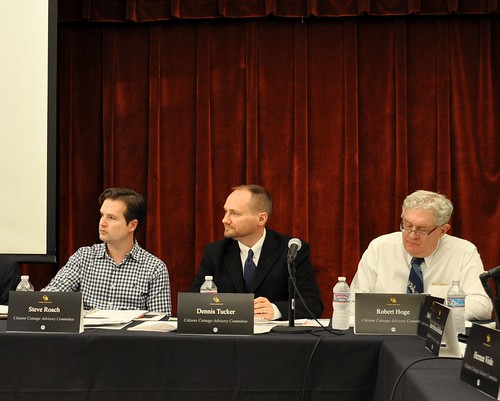
Steve Roach, Dennis Tucker, and Robert Hoge at a June 2016 meeting of the Citizens Coinage Advisory Committee in Colorado Springs. (Photo courtesy of Caleb Noel, ANA)
The ANA Summer Seminar guide describes the class:
“From traditional print publications to new online media, there have never been more opportunities for numismatic writers to reach and connect with an audience. Online resources, from The Numismatist archives to the Newman Numismatic Portal, provide new opportunities for researchers.
This practical and fun course will help collectors—beginning to advanced—write about coins for today’s coin publications.
Students will get an overview of the various venues available for publishing today, the elements of quality (readable) coin writing, and the many different types of writing from auction-lot descriptions to academic research papers. During the class students will build an outline and work on producing an article suitable for publication, including gentle peer-review to help build individual writing skills. By the end of the class, students will lay the groundwork for a paper that they can be proud of and gain confidence in their writing skills.”
The course will feature projects and special guest instructors, and plenty of time for questions- and-answers with Roach and Tucker, two of the hobby’s most prolifically published writers. Roach has written more than 500 articles and has won numerous awards for his reporting, analysis, and commentary. Tucker has published more than 300 books by authors including Q. David Bowers and Kenneth Bressett, has written hundreds of numismatic articles, and is the author of the award-winning book American Gold and Silver. Both have served on the Treasury Department’s Citizens Coinage Advisory Committee, and both have taught courses on writing and have lectured nationwide on numismatics.
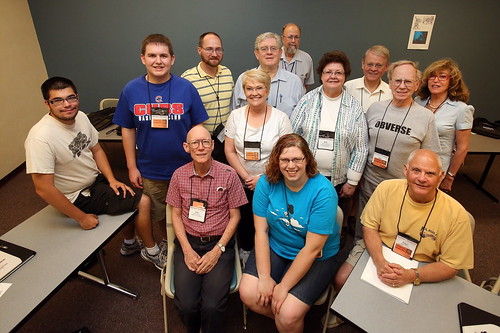
Students from a 2013 ANA Summer Seminar class on writing, research, and publishing, co-taught by Dennis Tucker, Beth Deisher, Ken Bressett, and Robert Hoge. (Photo by Robert Kelley, ANA)
The ANA Summer Seminar is a once-a-year opportunity for numismatic learning and camaraderie that offers students a varied selection of week-long courses designed for discovery or continued study. For more than 40 years, Summer Seminar has featured classes to suit virtually every collector’s hobby needs. “Most importantly,” says the ANA, “everyone attending Summer Seminar shares a common trait: a passion for numismatics.”
To learn more about “Numismatic Publishing” and other ANA Summer Seminar courses, visit www.money.org/summer-seminar.

2018 ANA SUMMER SEMINAR COURSE CATALOG
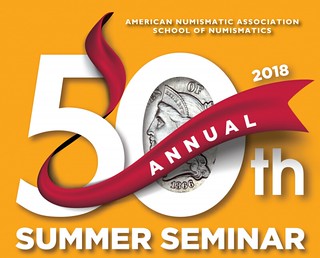 Welcome to the best learning experience in numismatics, the American Numismatic Association’s 2018 Summer Seminar. This is truly an extraordinary event at a very special place, where the distinction between teacher
and student blurs because you always are a little of each.
Welcome to the best learning experience in numismatics, the American Numismatic Association’s 2018 Summer Seminar. This is truly an extraordinary event at a very special place, where the distinction between teacher
and student blurs because you always are a little of each.
The classes, tours, auctions, and meals see two or three generations of numismatists mingling without barriers of age, experience, education or wealth. Summer Seminar is about making new friends, reuniting with old ones and staying up a little late in bull sessions or at the “Moonlight Lounge.” Sleep? That’s for later. Learning is for now.
Here are just some of the topics offered this year: Grading United States Coins, Detecting Counterfeit and Altered Coins, Coin Photography, Roman Coinage, National Bank Notes, Colonial Americana, Military Numismatics, Coin Carving and Early American Coppers.
Your classes are true seminars: students gathered in small groups with everyone an active participant. You’ll learn from instructors who are recognized leaders in their fields, and from the collective experiences of fellow students, who range in age from teenagers to seniors.
Students also have many opportunities to visit the ANA’s Edward C. Rochette Money Museum and Dwight N. Manley Numismatic Library.
Rarely do students or instructors attend just one Summer Seminar. More than 70 percent of them come back time and time again for the education, friendships and camaraderie. There are reasons our students and instructors are so loyal and enthusiastic about Summer Seminar. Try it and see.
To read the complete catalog, see:
2018 Summer Seminar Course Catalog (https://www.money.org/uploads//2018-summer-seminar-catalog-opt.pdf)
PNG CALLS FOR 2018 AWARDS NOMINATIONS
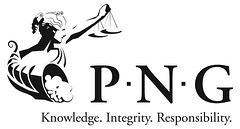 Nominations now are being accepted for the 2018 Professional Numismatists Guild awards, according to PNG Executive Director Robert Brueggeman and President Barry Stuppler.
Nominations now are being accepted for the 2018 Professional Numismatists Guild awards, according to PNG Executive Director Robert Brueggeman and President Barry Stuppler.
“Each year the PNG publicly recognizes outstanding achievements in the hobby and the profession by honoring deserving recipients with awards in a half-dozen categories. We cordially welcome and strongly encourage nominations from all collectors and dealers,” said Brueggeman.
“The award winners will be announced at the annual PNG Day banquet that will be held following the PNG Day show (www.pngdealers.org/png-events) in the Pennsylvania Convention Center in Philadelphia on Monday, August 13, 2018. That is the eve of the American Numismatic Association’s World’s Fair of Money® at the convention center,” explained Stuppler.
Nominations should be made by June 1 directly to the appropriate award category officials. The categories and contacts are:
Lifetime Achievement Award: Presented to a numismatist for his/her extraordinary devotion to numismatics and who, over their lifetime, significantly contributed to the hobby or profession. Committee Co-Chairs: Barry Stuppler and Dana S. Samuelson. Emails: Barry@Stuppler.com and Dana@AmerGold.com.
Robert Friedberg Award: Presented to an author in recognition for an outstanding book or other literature. Named in honor of a publisher and author of numismatic reference books, this award is not automatically given each year. It is only given when there is deemed to be a worthy recipient or recipients. Committee Chair: James A. Simek. Email: nge3@comcast.net. Note: A copy of each book nominated for this year’s award must be submitted for delivery no later than June 1, 2018 to James A. Simek, P.O. Box 7157, Westchester, IL 60154-7157. Email: nge3@comcast.net.
To read the complete article, see:
PNG Calls For 2018 Awards Nominations (https://pngdealers.org/png-calls-for-2018-awards-nominations/)
NUMISMATIC NUGGETS: APRIL 8, 2018
1858 Honourable Artillery Company Canteen Token

Description: Great Britain, Honourable Artillery Company canteen token, gilt brass threepence, 1858 (Yarwood BMT 093). With most gilt intact, a few minor marks, otherwise extremely fine.
To read the complete lot description, see:
Lot 559: Miscellaneous Tokens and Checks (https://www.invaluable.com/auction-lot/-1-c-6AB417CBE1)
1860 Hogarth and Erichsen Silver Threepence
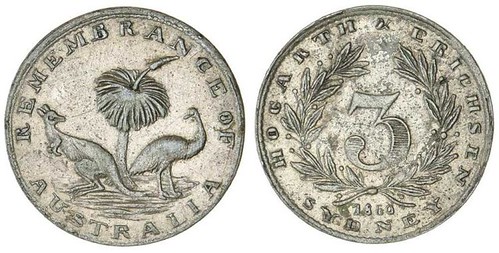
Description: Hogarth and Erichsen, Sydney silver threepence, 1860 (A.691). Light glossy grey tone, good very fine.
To read the complete lot description, see:
Lot 545: Australian and New Zealand Tokens (https://www.invaluable.com/auction-lot/-1-c-76143BBA76)
Australia WWII Internment Camp Token
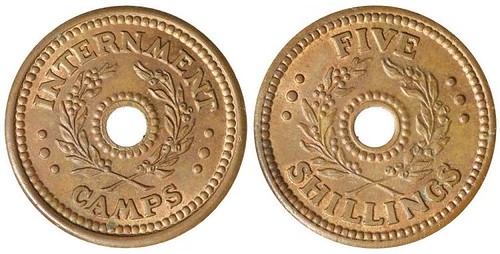
Description: Commonwealth of Australia, World War II Internment Camps, five shillings. Dull brown toning with some original mint red, nearly uncirculated and rare. Ex Barry McGown Scott Collection, from International Numismatics 23/12/2002.
To read the complete lot description, see:
Lot 548: Miscellaneous Tokens and Checks (https://www.invaluable.com/auction-lot/-1-c-9614E66A62)
CONTAMARCHE F.C. MARINO Token
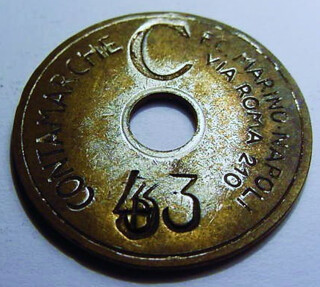
Description: CONTAMARCHE F.C. MARINO, NAPOLI VIA ROMA 210 ITALY TOKEN
To read the complete lot description, see:
Lot 129: CONTAMARCHE F.C. MARINO, NAPOLI VIA ROMA 210 ITALY TOKEN (https://www.invaluable.com/auction-lot/-1-c-F6D4B018F4)
Mount Carbon Railroad Company Token
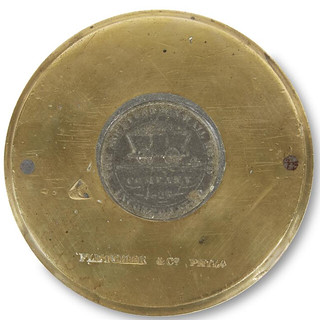
Brass and lead token for The Mount Carbon Railroad Company
Stamped, "Fletcher & Co Phila," 1829-1842
Diam: 4 in.
PROVENANCE:
Property of a New York City Collection.
Estimate $600-800
Probably made by Thomas Fletcher, a machine maker listed in early Philadelphia directories as being located at 162 Christian Street. The Mount Carbon Railroad Company incorporated in 1829 and later merged with the Philadelphia & Reading Railroad .
To read the complete lot description, see:
Lot 121 Brass and lead token for The Mount Carbon Railroad Company
(https://auctions.freemansauction.com/asp/fullcatalogue.asp?salelot=1600+++++121+&refno=++998682)
THE TERRIBLE NINTH CENTURY
MOST PEOPLE WHO ARE NOT MEDIEVALISTS would be hard pressed to name one thing that happened between the years 800 and 900. For many Europeans during that terrible century, it was the worst of times. Viking raiders descended from the north, Arab marauders attacked from the south, and kingdoms in between were repeatedly torn by dynastic civil wars. Disruption of trade and shrinkage of the economy made coinage in this chaotic era scarce, and like most coins of the so-called “Dark Ages” they are not much to look at.
But they have quite a few stories to tell.
The Franks
On Christmas Day in the year 800 in Rome, Pope Leo III crowned Karl, King of the Franks (742-814), as Emperor of the Romans, a post considered vacant because a woman, Irene, ruled the eastern empire in Constantinople. We
know him better by his French nickname, Charlemagne (“Charles the Great”).

Most coins issued in Karl’s name identify him only as king of the Franks (REX FR). The imperial title (IMP AUG) appears on rare portrait coins, struck either for the coronation in 800 or for the Byzantine recognition of such in 812.
To read the complete article, see:
CoinWeek Ancient Coin Series: The Terrible Ninth Century
(https://coinweek.com/ancient-coins/coinweek-ancient-coin-series-the-terrible-ninth-century/)

THE NUMISMATICS OF GOLF
As I was watching the Masters Golf Tournament on TV, I was wondering about what coins were being used as ball markers by the various players.
The Professional Golfers' Association (PGA) Rule 20-1 states in part, “The position of a ball to be lifted should be marked by placing a ball-marker, a small coin or other similar object immediately behind the ball.” While there's no penalty for using an object that's not similar to a plastic ball-marker or a small coin, you'll rarely see a PGA player use anything other than a small coin or flat disc to mark a ball.
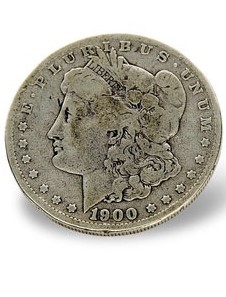 Some golfers use poker chips, medals, or other flat items, but most that I see use coins. My favorite golfer, Phil Mickelson, tells a story about his grandfather Al Santos, who kept in his pocket a silver dollar
from 1900 that he never spent. Instead, he rubbed the coin whenever he felt poor, a small comfort to know that he had money. " I have that silver dollar today, and I've used it as a ball marker during the AT&T
Pebble Beach Pro-Am as a marker, and will continue to do so," Mickelson said. This is the actual coin which Phil uses:
Some golfers use poker chips, medals, or other flat items, but most that I see use coins. My favorite golfer, Phil Mickelson, tells a story about his grandfather Al Santos, who kept in his pocket a silver dollar
from 1900 that he never spent. Instead, he rubbed the coin whenever he felt poor, a small comfort to know that he had money. " I have that silver dollar today, and I've used it as a ball marker during the AT&T
Pebble Beach Pro-Am as a marker, and will continue to do so," Mickelson said. This is the actual coin which Phil uses:
Jack Nicklaus said that he would never play a round of golf without three coins in his pocket—and it must be exactly three, no more, no less. The denominations didn’t matter to the Golden Bear, and as long as three coins were jingling in his pocket, he could step out to the first tee.
Chi Chi Rodriquez, like Nicklaus, also always carried three coins on him but his approach was a little different. He would mark his birdie putts with a quarter, his eagle putts with a buffalo nickel, and if things weren’t going his way, he’d switch to a gold coin.
Tiger Woods always places his coin with heads up. This is because, as an amateur in 1996 he was asked to move his marker to allow play for his competitor. He almost forgot to move it back before playing, which would have meant a penalty. His competitor reminded him, so he avoided the penalty. Ever since, he always places his coin heads up, and if he is asked to move it he then places it tails up - thus he is able to avoid any confusion. Davis Love III believes that all coins minted after 1970 are deemed to be bad luck. This is why he prefers pennies minted in the 1960s.
Maybe some other readers have stories to tell. Here are some other ball makers currently in use:
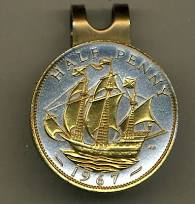
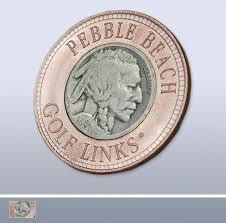
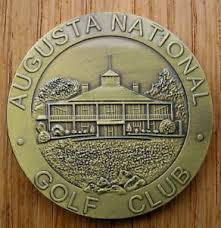
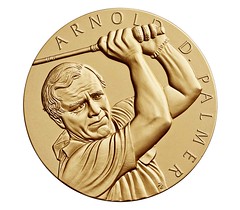
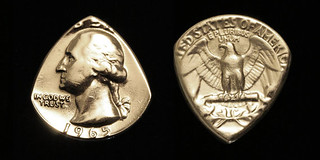
As for me, I prefer my personal challenge coin:
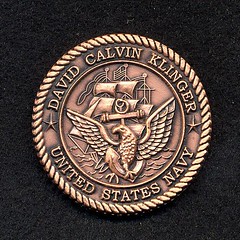
David adds:
I almost forgot to include this numismatic connection from Tiger Woods. Tiger won his first Pro championship in 1996, at age 20, at the Las Vegas Invitational. Notice that one of his three trophies has a Morgan Dollar motif.
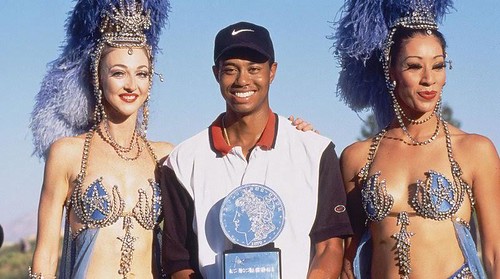
SCHRAUBTALER: MEDAL WITH A HIDDEN STORY
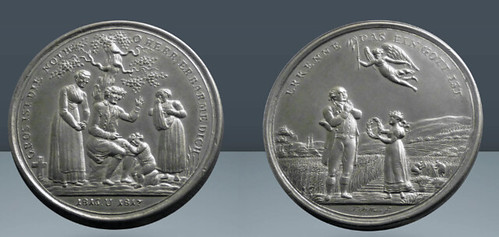
Schraubtaler. Nürnberg, Germany. 1817
Tin medal with hidden story, 32.43g (48mm, 12h). Depiction of starving family under a tree / Praying farmer in fertile landscape receives from a harvest wreath from girl, above angels. Within the taler are eight connected double-sided colored copper engravings and descriptions, four of which show the year of need (1816) and four the good year (1817), in the inside cover there are two glued, black and white copper engravings: 1816/1817 and a table with a comparison to 1771 in Bavaria.
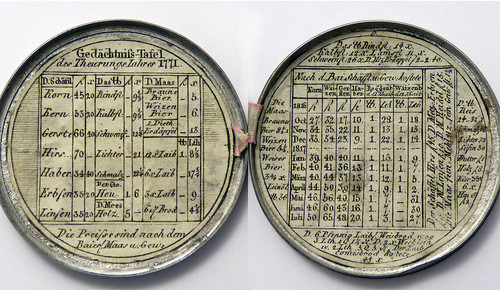
These fascinating pieces are “coins” that can be separated into two parts and contain something inside whether it be a portrait of a loved one, story or precious item. They were extremely popular, particularly in Germany in the 1700 and 1800’s. The earliest known schraubtaler used coins from from 1486-1525. Many times, the coins used to construct the schraubtaler were from different cities and various dates, but most were out of circulation. The artistry and stories encapsulated within the coins are fascinating. For example, this particular piece details the starvation that took place in Germany in the year 1816. It also compares the year 1816/1817 to 1771 in Bavaria. This piece was made in Nürnberg, however, the majority of schraubtalers came out of Augsburg. These pieces reflected religious and political issues of the time.
Schraubtalers were given as a present, a commemorative gift for a wedding or baptism, or for distinguished honors. Sometimes in arranges marriages, they were used to give a future spouse a glimpse of their future partners with a portrait enclosed. They also used them as packaging for precious items. For example, Queen Maria Theresia gave the bodyguard for her bedroom half a ducat that she enclosed in a schraubtaler. The most interesting thing about a schraubtaler is undoubtedly the content. The earliest have engravings or oil portraits put directly on the inside of the talers.

References: Pressler 439 (on colored plates within). Erlanger 6
Shanna confirmed my guess. She writes:
That is exactly what it means. It is a specialized term in German.
To read the complete article, see:
Schraubtaler. Nürnberg, Germany. 1817 (https://www.shannaschmidt.com/world/schraubtaler-nrnberg-germany-1817)
HOW THE CHALLENGE COIN TRADITION STARTED
The Challenge Coin Tradition: Do You Know How It Started?
If you served in the Army or had any connections to it in the past whatsoever, there is a great chance that you are already familiar with the institution of challenge coins. If you didn’t have the opportunity to familiarize yourself with the subject, I strongly advise looking at the guide by Embleholics (linked below).
Coins were most often presented to the military members who displayed exceptional performance and outstanding courage while performing his military duties. Therefore, these small tokens are a source of great pride by those they originally presented to.
But, how did this tradition started and where?
Since there were no official military records regarding the inception and existence of challenge coin tradition, I had to dive into the unspoken word of the Internet and try to find an answer to this question. Here is what I found.
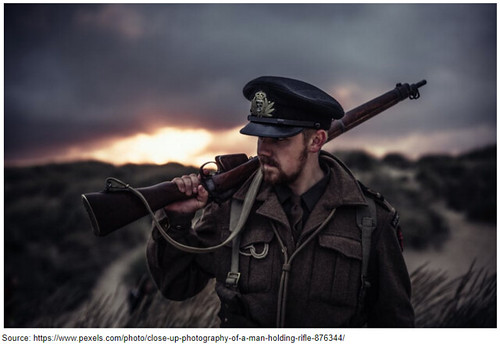
Most Common Theory
By what can be most commonly found, challenge coins date back to the WWI. By the time USA Army decided to join in the war, there were lots of young students who volunteered for their newly formed Air Squadron.
Namely, one of them was a wealthy lieutenant who wanted all the brave recruits to be presented with some kind of insignia that will help them be recognized throughout the troops and among themselves. He then ordered bronze coins to be engraved with the insignia of the US Air Forces, and presented a coin to each one of his comrades.
Apparently, things weren’t going so well on the battlefront for him and he was unlucky enough for his aircraft to be gunned down and he was captured by the Nazis. They stripped him of his belongings, but he somehow managed to escape and made it to the other side of the battlefield on foot.
When he reached the Allied camp, French soldiers arrested and imprisoned him accusing him being a German spy because he had no ID to show to them. Luckily enough, one of the French soldiers recognized the insignia of the US Army on his challenge coin, which ultimately saved his life.
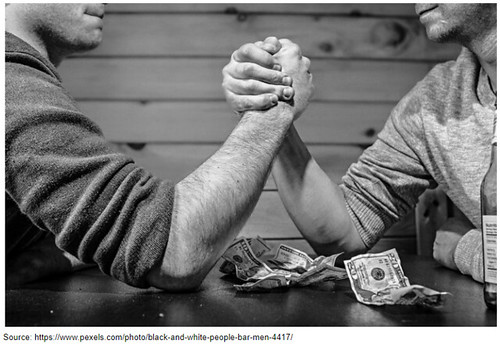
More Probable Theory
I think that everyone will agree that the previous story sounds a bit like a fairy tale and it’s too weird to be true. So I kept searching for other solutions and stumbled upon one story that truly feels more realistic than
the previous one.
This one dates back to the Vietnam war. Apparently, there were military-ran bars on the battlefront. People from the Army didn’t like non-military presence in their bars. So someone came up with an idea for every member of the Army to be presented by a coin, specially designed with the emblem of his own unit.
Therefore, whenever someone walked into a bar, he had to show his coin as a sign of recognition. This practice further developed into what’s today known as ‘’challenge coin’’, where any visitor could challenge at any time everyone else present in the bar to show their coins.
If someone didn’t have his coin with himself, he had to buy a drink for all of the others. This tradition carried on to this very day.
Challenge Coins Today
Challenge coins relate to many different professions and organizations and are not necessarily exclusive only to the military.
Collecting challenge coins and storing them in a special way had become sort of a hobby. Like there’s a proper way of packing books, there is an advisable way of how to store and handle your challenge coins.
Some of them have great value (materialistic value, and not only sentimental and emotional as was the case before), and there are even coin traders specialized only in buying and selling these items.
To read the complete Embleholics Challenge Coin guide, see:
All You Need To Know About Challenge Coins (https://embleholics.com/challenge-coins/)
NIOBIUM COIN CASE STUDY
When does a metal become precious?
Niobium is a metal that was not discovered until the 19th century and it first found commercial use in the early 20th century. It is now considered a precious metal and mints around the world use it for numismatic offerings.
Niobium is mostly alloyed with other metals to create superalloys with enhanced strength and superconductivity. As the demand for these uses grew, so did the metal’s price. The cost of niobium began to increase rapidly in 2000, when it went up by 52%. In 2001, its value went up another 26%. By 2010 the price had increased to three times what it was in 1999. Following this demand, investing and trading in the metal began to take off. Numismatic demand soon followed when Austria issued the first niobium coin.
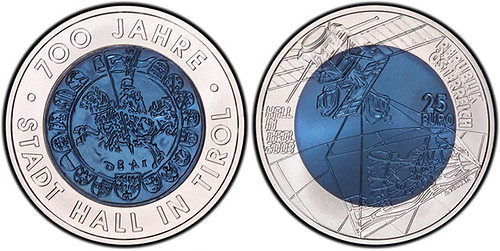
2003 Austria 25 Euro Tyrol Commemorative, the first niobium coin.
The Austrian Mint produced the first niobium coins for sale in 2003. The coin commemorated the 700th anniversary of the charter granted to the town of Hall in the state of Tyrol, Austria. The coin had a blue center with 7.5 grams of niobium housed in a silver ring of nine grams. The buying public received the coin well and the Austrian mint continues the series with a new niobium coin in a different color each year.
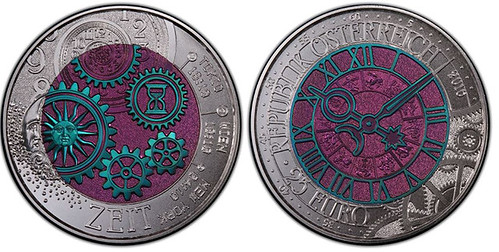
Austria continues its successful niobium series every year.
With the success of the Austrian niobium issues, other world mints began issuing commemorative niobium coins. In 2004, Latvia produced with the bi-metallic silver-niobium "Coin of Time" commemorative. Liberia issued a series of full niobium coins with gilt devices in 2005 to commemorate the 10th anniversary of the Euro. In 2005, Sierra Leone issued a bi-metallic niobium ring with a gold center featuring Pope John Paul II. Also in 2005, Mongolia issued a bi-metallic niobium-silver coin with niobium in the shape of a snow leopard. Palau, Canada, Luxembourg and the British Virgin Islands also issued niobium coins.
To read the complete article, see:
When Is a Metal Precious? Niobium Coin Case Study (https://www.pcgs.com/news/when-is-a-metal-precious-niobium-coin-case-study)

ROYAL CANADIAN MINT ISSUES UFO ENCOUNTER COIN
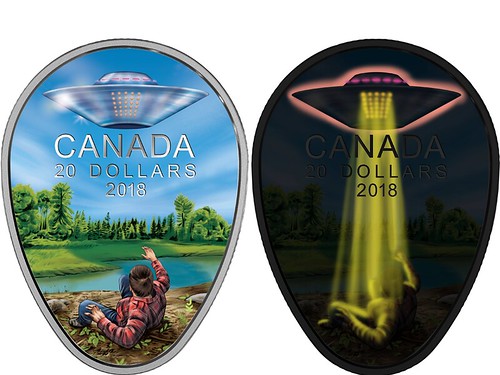
The Royal Canadian Mint is releasing a limited-edition $20 coin to commemorate the unusual story of a Manitoba man’s close encounter with a flying saucer.
The one-ounce silver coin being released Tuesday immortalizes Stefan Michalak’s experience in Whiteshell Provincial Park, east of Winnipeg, more than 50 years ago.
Michalak said he suffered burns when he came across an unidentified flying object in what became known as the Falcon Lake incident in May 1967.
The coin carries the standard engraving of the Queen on one side and on the other displays a full-colour depiction of Michalak falling to the ground, with a forest and lake behind him, while a flying saucer hovers above him.
Like the story, the coin is unusual because it’s oval-shaped and comes with a black light flashlight which the mint says gives the reverse side an otherworldly glow.
Erica Maga, the mint’s product manager, said special dies needed to be cast to create the ovoid-shaped blanks for the coins, so more time was needed to produce these compared to the ones in people’s pockets.
“We can only make a couple of hundred coins per shift. A lot of hands go into something like this,” she said.
To read the complete article, see:
Canadian mint releases glowing oval coin depicting 1967 UFO
encounter in Manitoba (http://calgaryherald.com/news/canada/canadian-coin-depicting-out-of-this-world-experience-released-by-mint/wcm/d7d7efbe-6634-47a3-a082-0a522fa4b80f)
CANADIAN INSTITUTE FOR THE BLIND COIN DESIGNER
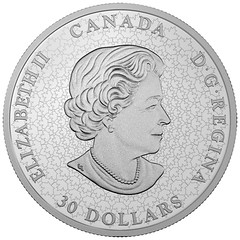
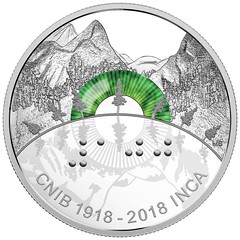
Kitchener artist Meghan Sims has designed the coin to mark the 100th anniversary of the Canadian National Institute for the Blind.
She said the coin is steeped in symbolism and celebrates the past and the future of the community.
Sims's design for the Royal Canadian Mints's project marks a different turn for them as its the first time they've included braille on a coin and commissioned an artist who has a rare visual condition that does not allow her to see colours. Sims has achromatopsia, which means she sees only a few feet in front of her, in grayscale and is extremely sensitive to light.
"Never did I think that I would have this opportunity to speak for the CNIB and it brought home that sense of pride I was looking for to represent others," Sims said.
"I just feel very proud, to be blind, partially sighted in Canada today."
Sims explained her coin on an interview with CBC K-W's The Morning Edition. The highlights she noted:
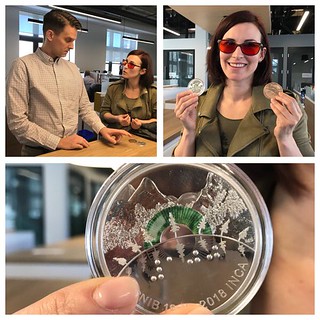 • A convex horizontal line signifying a horizon.
• A convex horizontal line signifying a horizon.
• A circle that doubles as an Iris represents a setting sun and a rising moon suggesting the element of time past and future
• Seven Jack Pine trees represents the seven gentleman who started the CNIB in 1918. As well Jack Pines grow in harsh environments and thrive after a forest fire.
• A forest, which Sims describes as a place of refuge for her because of her visual condition. Meghan is light sensitive and finds the forest represents a place of safety and refuge, just like the CNIB.
• In Braille, engraved is CNIB-100-INCA.
To read the complete article, see:
CNIB centennial coin by Kitchener artist etched in symbolism
(http://www.cbc.ca/news/canada/kitchener-waterloo/cnib-meghan-sims-kitchener-artist-1.4595298)
To read the earlier E-Sylum article, see:
CANADIAN NATIONAL INSTITUTE FOR THE BLIND COIN (http://www.coinbooks.org/v21/esylum_v21n12a28.html)
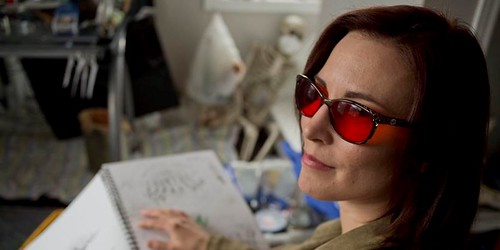
Greens call her. Green speaks to her.
It is the colour of the emerald iris on a commemorative silver coin and bronze medallion set she designed for the Royal Canadian Mint. The set honours 100 years of the Canadian National Institute for the Blind.
Both discs include the number "100" engraved in braille.
"Green is actually my favourite shade of grey," explained Sims, whose rare visual condition is called achromatopsia.
"Green is said to be the most calming and restful colour to the eye because of how it reflects light. It also represents growth and prosperity and hope."
That's why she chose green to oversee seven jack pines, growing defiantly on harsh, rocky shores.
"I wanted that to represent the deaf-blind community in the face of adversity," said Sims, noting that they also represent the seven founding members of the CNIB. "We stand strong and proud."
Sims can be proud too. Her Canadian coin set is the first one designed by a visually impaired artist. She started with ink and a crow's feather quill while listening to some tunes by The Be Good Tanyasand Taken By Trees to set the creative mood. She had a month to submit her sketches after being asked by the Mint to take a run at the concept.
Now, when she holds the coins close, she sees her grandmother Marie's face. Marie, who used to collect such coins and gift them to her grandkids for Christmas, is gone. But the coins carry her sparkle.
"It's funny, giving coins as gifts was so characteristic of her," Sims said. "I suppose I took it for granted. I could have never imagined that my grandmother gifting coins all those years ago would have such sentimental significance to me today."
To read the complete article, see:
Freshly minted art (https://www.therecord.com/news-story/8372270-freshly-minted-art/)
BANKNOTE FEATURES CANADIAN HUMAN RIGHTS MUSEUM
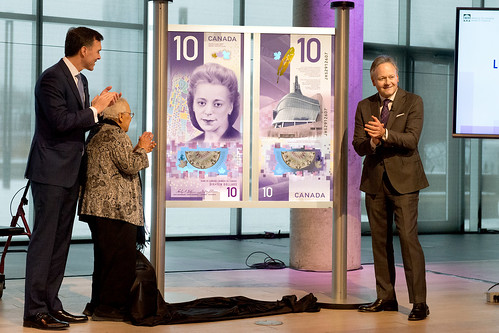
The Bank of Canada has recently unveiled a new $10 banknote featuring Viola Desmond, a black Nova-Scotian businesswoman who challenged racial segregation in 1946 by refusing to vacate a "whites-only" area of a theater. To reinforce this pro-human rights message, the reverse side of the bill will feature an image of the Canadian Museum for Human Rights, designed by Antoine Predock and completed in 2014.
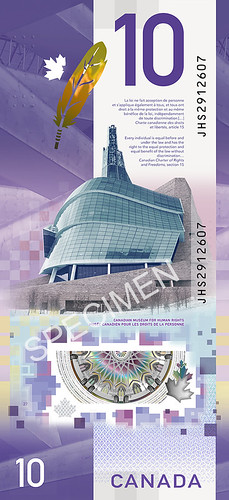 Ms. Desmond was selected for the $10 bill by Finance Minister Bill Morneau after an open-call to Canadians to nominate an iconic Canadian woman to appear on the redesigned banknote. According to the architect,
Antoine Predock, the Canadian Museum for Human Rights "makes visible the fundamental commonality of humankind. The abstract ephemeral wings of a white dove embrace a mythic stone mountain of 450 million-year-old Tyndall
limestone culminating in the Tower of Hope."
Ms. Desmond was selected for the $10 bill by Finance Minister Bill Morneau after an open-call to Canadians to nominate an iconic Canadian woman to appear on the redesigned banknote. According to the architect,
Antoine Predock, the Canadian Museum for Human Rights "makes visible the fundamental commonality of humankind. The abstract ephemeral wings of a white dove embrace a mythic stone mountain of 450 million-year-old Tyndall
limestone culminating in the Tower of Hope."
On the reverse side of the bill, the building serves as the main image acting as a landmark for not only the museum's message but its relationship to the context in which it is situated.
"Our banknotes are designed not only to be a secure and durable means of payment but also to be works of art that tell the stories of Canada. This new $10 fits that bill,” said Governor Poloz.

To read the complete article, see:
New Canadian $10 Bill to Feature Antoine Predock's Canadian Museum
for Human Rights (https://www.archdaily.com/891142/new-canadian-banknote-celebrates-civil-rights-with-black-female-activist-and-canadian-museum-for-human-rights)
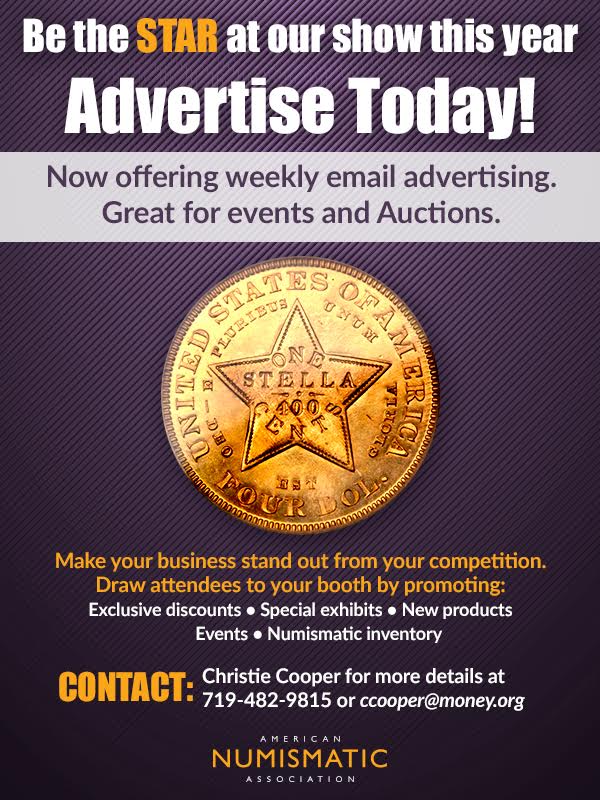
GARRETT COLLECTS SMALL SIZE KENTUCKY NATIONALS
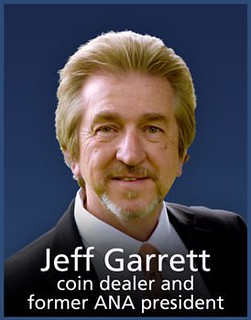 Each year for the last few decades, I have bought and sold millions of dollars’ worth of rare coins. I have had the privilege of handling a lot of great numismatic rarities.
Each year for the last few decades, I have bought and sold millions of dollars’ worth of rare coins. I have had the privilege of handling a lot of great numismatic rarities.
Most of these simply pass through my hands and are now only memories. A lot of the coins were sold to what I would call “passionate collectors.” These are individuals who have picked an area of the market to collect and pursued it with zeal. Passionate collecting can be a young person who is desperate to fill their Lincoln Cent album (me 45 years ago), or someone who is willing to spend millions to have the number one set registry of a series.
I believe collecting rare coins can be like a love affair. Your interest can be piqued by a first encounter. Later you learn more, and your interest grows. Slowly you become enamored and, before you know it, you have fallen in love.
I have known dozens of collectors who have fallen in love with a series or area of the market and pursued those coins with absolute passion. Not coincidently, these type of collectors are excellent customers. Cost is never an obstacle for an important acquisition.
I have recently experienced the above cost dilemma when I was able to find the last Kentucky small size National Bank Note to complete my collection. I now have an example from every town and city in Kentucky that issued these interesting bank notes.
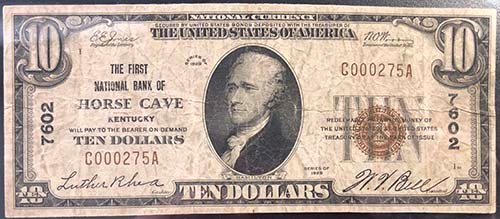
A total of 87 towns issued small size Kentucky Nationals. My final acquisition was a $10 bill from The First National Bank of Horse Cave, Kentucky. Only two examples are currently known, and I had been searching for years. When offered the note at the recent Baltimore show, I asked to take the piece to my table for consideration. The price was astoundingly high, but in my heart, I knew I would never give it back.
My journey of collecting small size Kentucky Nationals began about 15 years when I was given a great head start. I brokered what was then the best collection of Kentucky National Bank notes to my great friend, Bill Gale. The collection was astounding, and one of the best collections from any state that had ever been assembled. Bill's interest was primarily focused on the many important large size Kentucky Nationals. He offered me the partial collection of about 40 different small size notes. Having been born in Kentucky and living here for the past 35 years, this sounded like a fun project.
I choose to collect the small size Kentucky Nationals for affordability. The Large Size portion of the collection was nearly a million dollars, and more than I could justify taking out of my business. Bill Gale later sold the Large Size portion of the collection at a Heritage auction, and the catalogue is a standard reference for that part of the market.
Over the next 15 years, I would spread the word among paper money dealers of my interest in Kentucky small sizes. I also checked every auction catalog and price list. At first, the collection grew rapidly. More recently, as the collection grew, it became very hard to find notes needed for my set. In the last few years, I have only acquired a couple of notes.
There are several reasons I have fallen in love with small size Kentucky Nationals. I very much enjoyed the chase of trying to locate an example from every town and city that issued notes. Many of these have charming names, and are literally “one traffic light” hamlets. I also have many friends and relatives from these towns, and I greatly enjoy sharing them at gatherings. I was born in Glasgow, Kentucky, and notes from that town are among my favorites.
To read the complete article, see:
Collecting with Passion (https://www.ngccoin.com/news/article/6540/)
INDIAN COLLECTOR OF ERROR BANKNOTES PROFILED
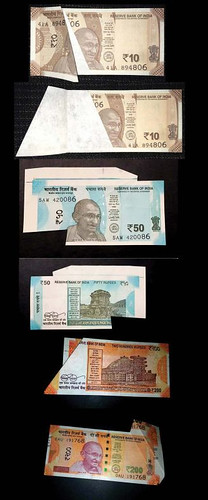 Most of us have been asked that plain straight question: ‘What are your hobbies?’ Your brain scans for something interesting to say to try and make yourself sound more sophisticated. Perhaps you're part of a
sports team, you go to the gym, enjoy reading, watching TV, gardening, coin collection, foreign currency collection, stamps...The list goes on.
Most of us have been asked that plain straight question: ‘What are your hobbies?’ Your brain scans for something interesting to say to try and make yourself sound more sophisticated. Perhaps you're part of a
sports team, you go to the gym, enjoy reading, watching TV, gardening, coin collection, foreign currency collection, stamps...The list goes on.
But you probably don't regularly collect ‘error’ currency notes. That is a peculiar hobby and it’s been Kalady resident Shyju Kudiyirippil’s hobby for the past 20 years. With more than 500 error currency notes in his collection, Shyju, a senior public relations professional, and a numismatist for the last 16 years with membership in several numismatic societies and clubs in major Indian cities, says he started his hobby 20 years ago, when he found a Rs 100 note with abated colors on it. “That was a printing mistake and I bought it from another guy out of curiosity. Thus, I started collecting these error notes,” says Shyju.
He possesses some of the rarest collection of coins and notes with printing errors including the one rupee note that was printed during the British rule in 1917, a double-decked Rs 1000 note, Gandhi-less notes, notes without flag over the Red Fort, notes even without the Red Fort and overweight notes. He has everything. “These currency notes’ value goes beyond the actual value. Sometimes it is five times the actual value,” he added. Shyju also has a collection of notes brought out after demonetisation, with printing mistakes.
To read the complete article, see:
An unusual numismatic passion
(https://www.deccanchronicle.com/lifestyle/viral-and-trending/080418/an-unusual-numismatic-passion.html)
THE GLOBGLOGABGALAB
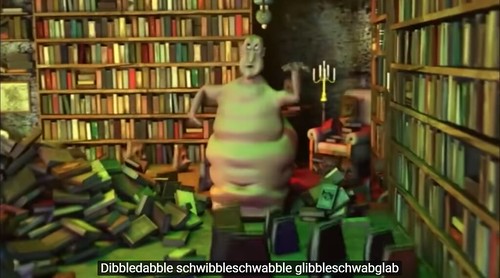
This animation clip just entered my brain by way of the Internet, and will probably be lodged there until I die. It’s from a CGI animated movie called Strawinski and the Mysterious House, apparently based on a chapter of an German audio drama, about a mole (Strawinski) and his animal friends who explore a mysterious house. It’s billed as “a magical adventure inspired by the Chronicles of Narnia, Walt Disney animated musicals, and the parables of Jesus Christ.”
One of the characters Strawinski encounters is a once-beautiful elf whose love of books turned him away from God (“The Great Elohim”) and transformed him into a monstrous slug-like grotesquerie. “I am the Globglogabgalab” is his big musical number. The Rat King—and I’m going by various reviews and plot summaries here—mind-controls Strawinski’s friends by tempting them to read books, and then the Scarlet Queen dissolves the books and saves everyone. Again, I’m paraphrasing. I haven’t seen the entire production.
One reviewer said this about the Globglogabgalab scene: “Oddly enough . . . it’s regarded as the least strange thing going on in the movie.”
I think our bibliophile readers will enjoy the idea of a warmly lit basement library full of dancing books. Less appealing is the idea of being caricatured as a fat, babbling, book-obsessed freak. But nobody ever said bibliomania would be a stroll in the park.
Enjoy! Here’s the scene: https://www.youtube.com/watch?v=W1dRBWyf6z8
and here’s a critique and analysis of the movie: https://www.youtube.com/watch?v=dhg6oTKcmW0
MOVIE MONEY: THE COINS OF ZAMUNDA
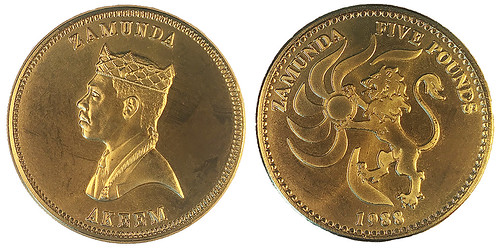
Bob Van Arsdell writes:
Attached are images of the Zamunda 5 Pound coin. These things are well-made coins and appear to be struck in brass or bronze. Internet says they were made by the Continental Coin Company, Van Nuys, CA. Apparently Paramount contracted with CCC to produce the coin and banknote for the movie. The Zamunda coin is 38-39 mm.
To read the earlier E-Sylum article, see:
MOVIE MONEY: THE BANKNOTES OF ZAMUNDA (http://www.coinbooks.org/v21/esylum_v21n09a39.html)
IN OTHER NEWS: APRIL 8, 2018
Kareem Abdul-Jabbar Leaves CCAC
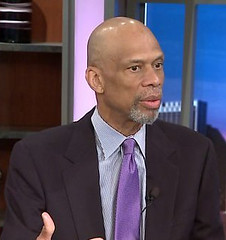 Mr. Kareem Abdul-Jabbar has informed the Acting Deputy Director of the United States Mint that he intends to step down from the Citizens Coinage Advisory Committee (CCAC) due to increasing personal obligations. He
was appointed to the CCAC in January 2017 as a member representing the interests of the general public.
Mr. Kareem Abdul-Jabbar has informed the Acting Deputy Director of the United States Mint that he intends to step down from the Citizens Coinage Advisory Committee (CCAC) due to increasing personal obligations. He
was appointed to the CCAC in January 2017 as a member representing the interests of the general public.
Abdul-Jabbar is a renowned former professional basketball player who is an avid coin collector. He became interested in numismatics through his love of history and his study of Alexander Hamilton. Abdul-Jabbar has agreed to remain on the CCAC until a successor is appointed, and remains committed to advancing numismatics, especially among minorities.
David Croft, United States Mint Acting Deputy Director, said, “It has been an honor to have Mr. Abdul-Jabbar on the CCAC this past year, and we appreciate his work in reviewing the projects that went before the committee during his tenure.”
To read the complete press release, see:
Kareem Abdul-Jabbar to Step Down from Citizens Coinage Advisory Committee
(https://www.usmint.gov/news/press-releases/kareem-abdul-jabbar-to-step-down-from-citizens-coinage-advisory-committee)
To read the earlier E-Sylum articles, see:
KAREEM ABDUL-JABBAR JOINS CCAC (http://www.coinbooks.org/v20/esylum_v20n04a20.html)
MORE ON NEW CCAC MEMBER KAREEM ABDUL-JABBAR (http://www.coinbooks.org/v20/esylum_v20n06a17.html)
Assay Commissioner Ted Dinkel Passed
Theodore H. Dinkel, 91, passed away on April 1, 2018.
He was a lifelong coin enthusiast and was one of 21 numismatists to receive a presidential appointment from Richard M. Nixon to serve on the 1973 Assay Commission. The Commission was responsible for testing a selection of 1972 coins to ensure they were minted in accordance with weight and metal provisions of the law.
Ted was a member of a variety of organizations including the New England Numismatic Association, the New Hampshire Numismatic Association and past president of the Cheshire County Numismatic Society. Later in life Ted took his love of discovering rare coins outside to become a metal detecting enthusiast and officer of the Yankee Treasure Hunters Club.
To read the complete article, see:
Theodore H. Dinkel
(http://www.sentinelsource.com/news/obituaries/theodore-h-dinkel/article_e1ca36ce-c162-52e3-84c9-00287d048bcd.html)
What happened to Kennedy half dollars?
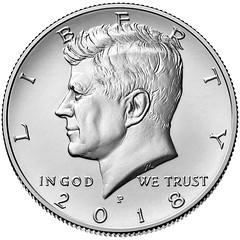
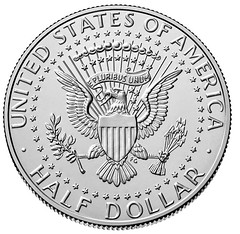
When the Treasury Department first released the coins to the public on March 24, 1964, a line that covered the entire block outside of the building in Washington bought all 70,000 initially produced half dollars within the first day, despite limiting purchases to 40 coins per customer! In 2018, it is virtually unheard of to see such excitement for the newly issued Kennedy half dollars. What happened?
To read the complete article, see:
What happened to Kennedy half dollars? (http://news.coinupdate.com/what-happened-to-kennedy-half-dollars/)
Marlboro man accused of trying to spend counterfeit money
To read the complete article, see:
Marlboro man accused of trying to spend counterfeit money
(http://www.recordonline.com/news/20180330/marlboro-man-accused-of-trying-to-spend-counterfeit-money)
FEATURED WEB SITE: BANKNOTE NEWS
This week's Featured Web Site is Owen Linzmayer's Banknote News - "Breaking news about international paper & polymer money".I started BanknoteNews.com to provide a forum for presenting breaking news about international paper & polymer money because I couldn't find anything like it on the Internet. While it is a lot of work to maintain, I have the pleasure of collaborating with avid collectors, dealers, and central bankers the world over to help spread current, correct, and comprehensive news and images about the very latest developments in this entertaining and educational hobby.
http://banknotenews.com/

